When Does Thw Weatee Start Getting Cooler Again
The La Nina stage has reached its peak. Cold anomalies are now expected to beginning weakening in early 2022, but the weather influence will last well into the Leap season. A transition to a neutral phase is expected by mid-year, with an El Nino expected to finally emerge in Fall, ready for the cold season of 2022/23.
Just what are these La Nina and El Nino events, and why practise they change the seasonal conditions beyond the entire earth? As yous will quickly detect out, they are actually both simply a role of a large old system that connects the body of water and the atmosphere called the ENSO.
We volition then look at the latest changing conditions across the ENSO regions, and what the latest forecast shows for ENSO in the coming months. You lot will see just how stiff of an influence these oceanic anomalies can force on the weather signals in the latest forecast for the remainder of the Winter Season in 2022 and into the adjacent Spring.
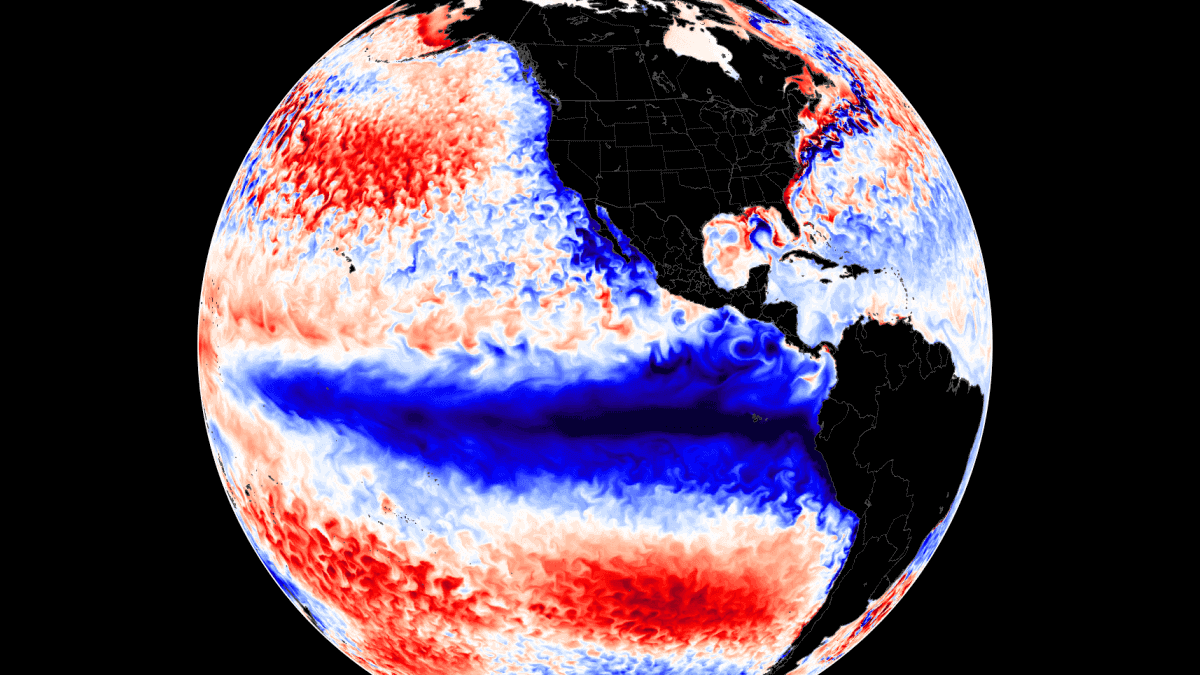
ENSO GLOBAL Weather IMPORTANCE
Keeping it simple, ENSO is short for "El Niño Southern Oscillation". This is a region of the equatorial Pacific bounding main. It is e'er changing between warm and cold phases, with phase changes taking from i-3 years.
ENSO has a major touch on on the tropical convection patterns (storms) and the complex substitution between the ocean and the atmosphere. Nosotros tin can observe large-calibration pressure level changes in the tropics with each developing phase. After some delay, these changes affect the circulation over the residue of the world.
The image below shows the ENSO regions in the tropical Pacific. Regions 3 and 4 cover the east and west and together embrace a large function of the tropical Pacific. Mainly all analysis and forecast focus on a combination of regions three and 4, seen on the paradigm as the Nino 3.4 region. Region 3 covers the eastern tropical Pacific, while region 4 covers the central and western parts.
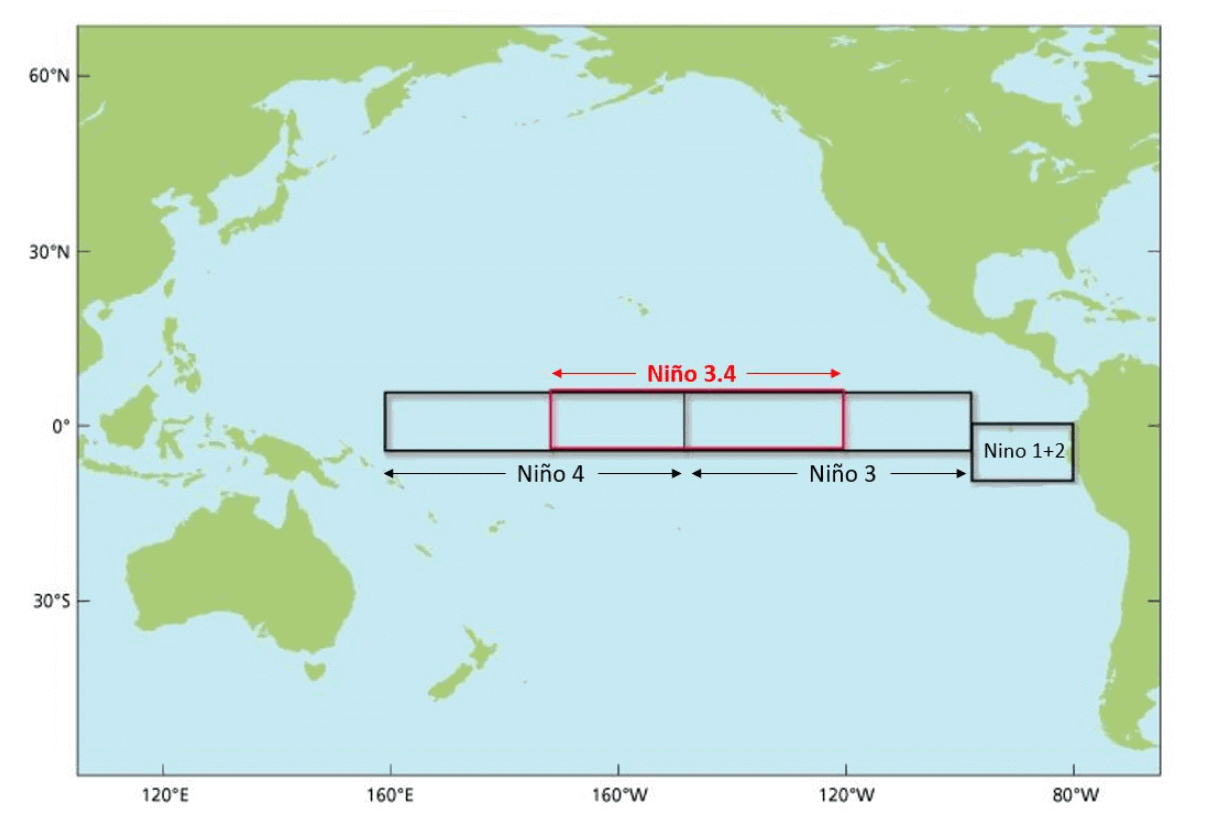
Each ENSO stage has a unlike upshot on the pressure and atmospheric condition in the tropics. This translates to the overall global circulation with time, influencing the conditions worldwide differently. A specific phase (cold/warm) usually develops between late summer and autumn and typically lasts till next summer. Only some events tin can final fifty-fifty upward to two years.
The common cold ENSO phase is called La Nina and the warm phase is called El Nino . The name La Nina literally translates to "the girl", and the name El Nino translates to "the boy", indicating an opposite dynamics betwixt the two phases.
We make up one's mind the ENSO phases by looking at the bounding main surface temperature anomalies (warmer/colder) in the ENSO iii.iv region, which you saw in the previous image to a higher place.
The image below from NOAA Climate shows the typical circulation during an enhanced warm ENSO stage (El Nino). Air descends in the western Pacific and over South America, causing stable and dry weather condition. At the aforementioned fourth dimension, the air is rising in the central Pacific, causing frequent thunderstorms, low pressure, and a lot of rainfall.
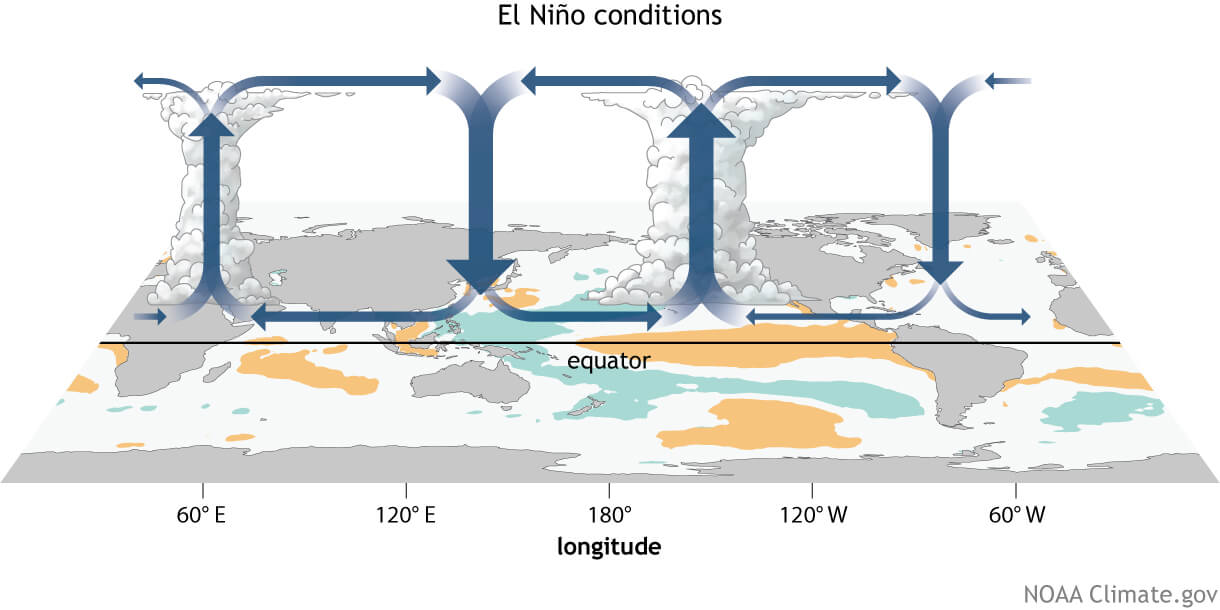
This way, ENSO tin can take a major touch on the tropical rainfall and pressure patterns and impacts the body of water-atmosphere feedback system. Through this ocean-temper system, the ENSO influence is then distributed globally. We usually detect a global shift in pressure patterns during the emergence of an ENSO stage but is more than influential during the peak of the phase.
But can de ENSO shift between cold and warm phases just like that? There is no unproblematic reply, only we can say that it is a result of the complex dynamics betwixt pressure patterns and winds. The tropical trade winds ordinarily initiate or stop a certain phase, by mixing the ocean surface layers and altering the body of water currents and thus temperature.
What are the trade winds? The merchandise winds are steady, and persistent winds, which blow towards (and along) the Equator in both Hemispheres. The prototype beneath from Weather.gov nicely shows a simplified schematic map of the global prevailing winds. Tropical trade winds are in yellow and ruby, covering both hemispheres.
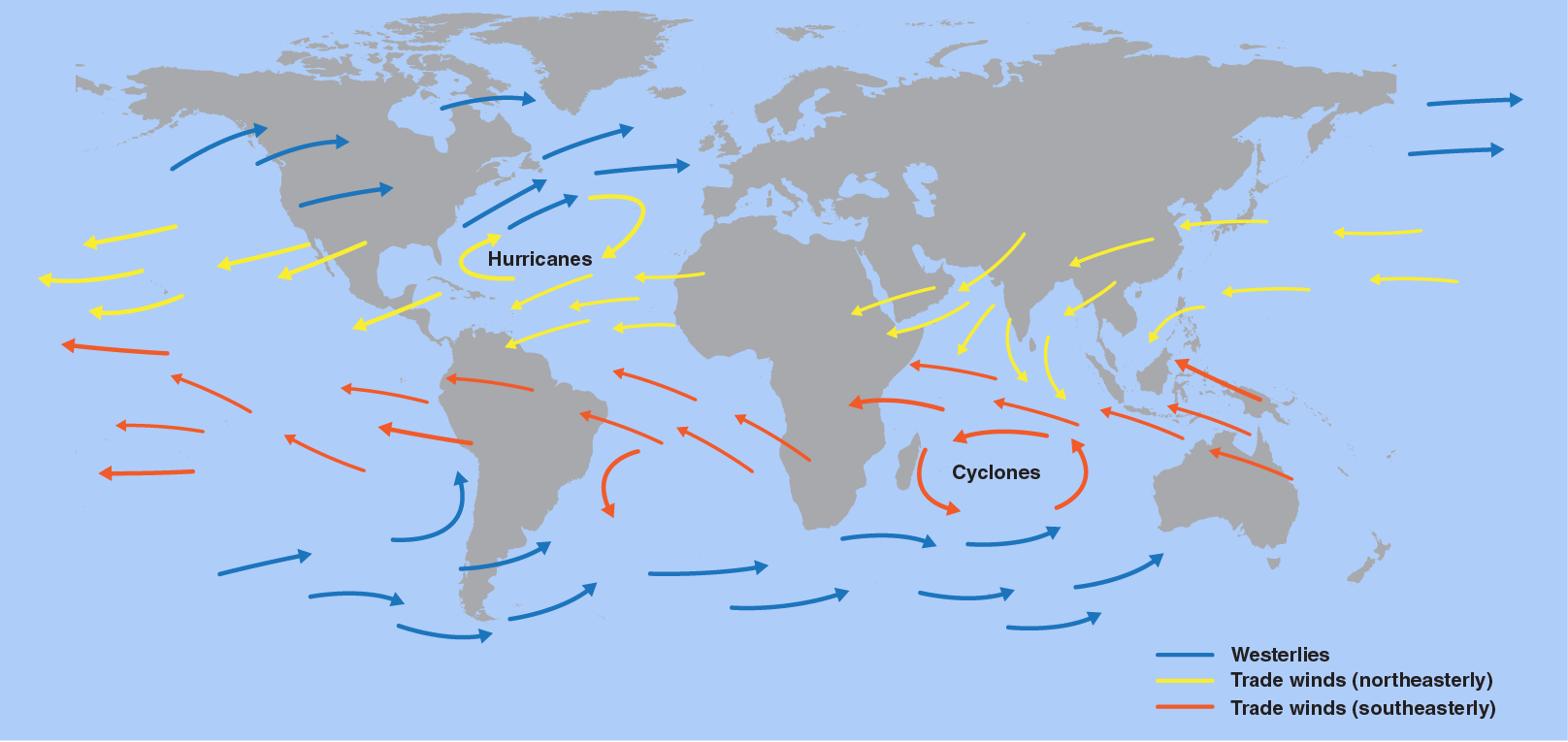
We produced a map that shows the prevailing near-surface winds, based on the actual data in the by decades. We tin can nicely observe the easterly trade winds in the Atlantic Sea and in the Pacific Ocean, which help to drive the ENSO region warming and cooling.

When these easterly winds get stronger, they can actually start changing the body of water surface currents, and they tin can starting time pushing the water from e to due west. This moves warm surface waters towards the west, bringing deeper (colder) waters closer to the surface to replace information technology.
This procedure is much improve seen on the video animation beneath, which shows the bounding main temperature anomalies from Summer to late Fall. You tin encounter new cooling starting in July, as the common cold "waveforms" develop across the equatorial Pacific. They form as the surface h2o is existence pushed westward past the trade winds, bringing replaced by deeper colder water.
The image below shows the latest ocean surface currents and temperature in the ENSO regions. Nosotros can all the same see strong easterly currents, which are pushing the water towards the west, cooling the sea surface. The easterly regions are usually always colder than the western due to stronger merchandise winds. This time last twelvemonth (top of the image), the cooling and trade winds were stronger in the central and western regions, while the eastern regions are libation this twelvemonth.
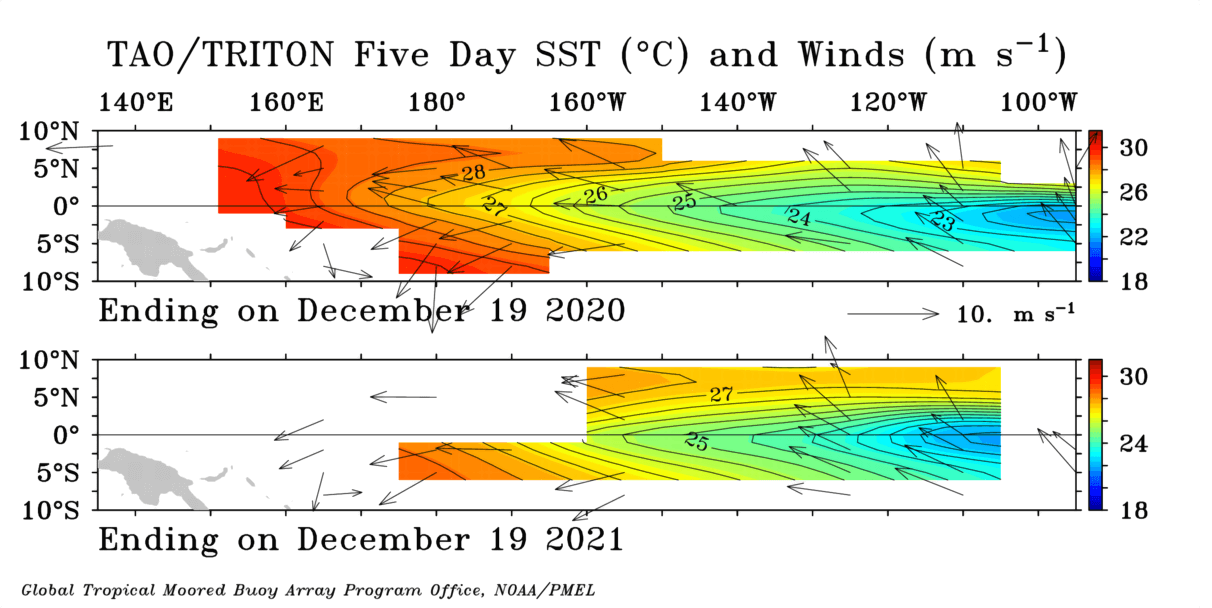
Only the hole-and-corner is not but in the winds themselves, as they are typically being driven by pressure changes. The ENSO phase direct responds to a unique atmospheric pressure variability, called the Southern Oscillation Index.
The Southern Oscillation Alphabetize or SOI represents the deviation in air pressure level measured at Tahiti (French Polynesia) and Darwin (Australia). The epitome below shows the location of the two pressure level zones that are important for ENSO.
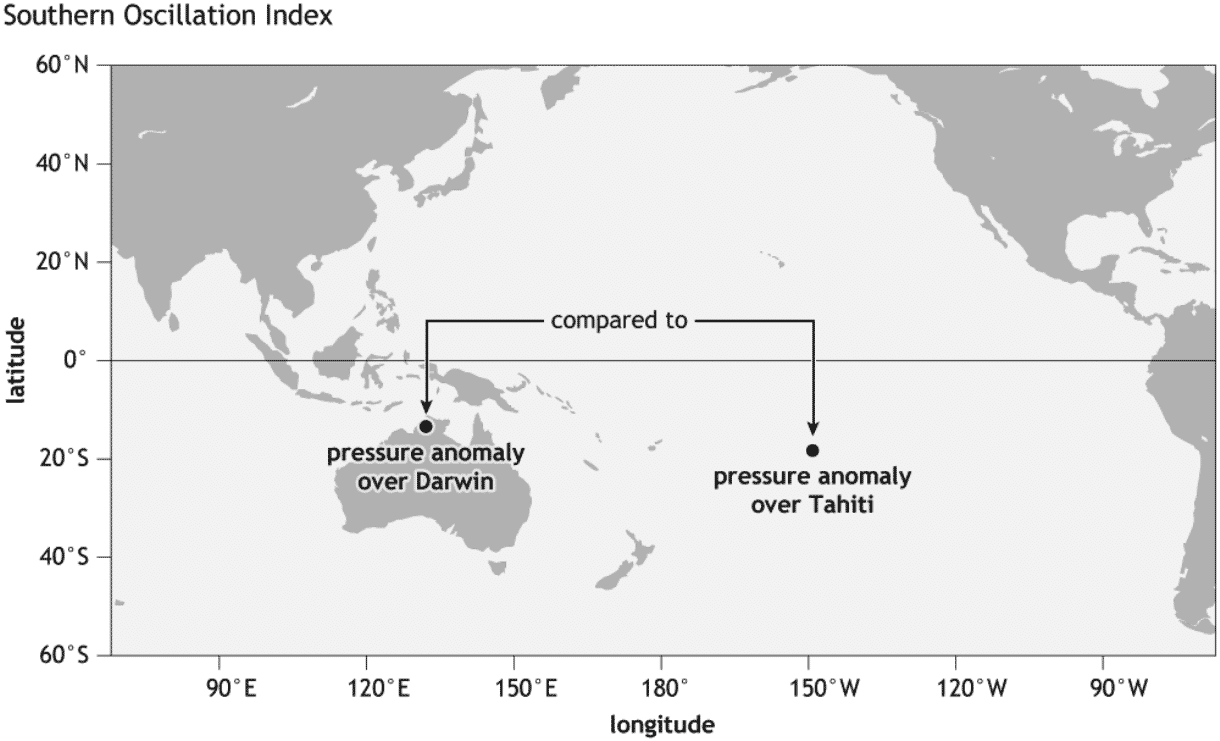
Positive SOI values hateful that the pressure level over the Tahiti side is higher than over Darwin in Commonwealth of australia. This corresponds to stronger easterly trade winds, supporting La Nina conditions.
Only during an El Nino, nosotros see lower pressure level in the eastern Pacific and over Tahiti, and higher over Darwin, Australia. This produces a negative SOI value and weaker trade winds, which ways less ocean cooling.
The SOI tells us what the pressure blueprint looks like in the tropical Pacific, which then affects the trade winds, warming or cooling the ENSO regions.
Below we take the 30-day average SOI index, which nicely the positive values and confirms the presence and further evolution of the cold ocean phase. The SOI can be used to determine the potential issue or direct influence of the ENSO phase on the climate in the western Pacific and Australia.

We can see on the confined, that the daily SOI has changed from positive to negative in the by few days. That could be something, naught, or everything. Changes in the SOI typically precede the changes seen later in the ocean, so every change is worthy of monitoring. Just for forecasting, nosotros typically apply multi-solar day data, similar 15 days or 30 days or fifty-fifty 90 days averaged SOI.
LA NINA – LATEST Evolution
Current global body of water analysis reveals the potent expanse of cold ocean anomalies in the tropical Pacific. This is exactly beyond the ENSO regions, seen earlier above. The "moving ridge-like" shapes of the common cold anomalies indicate strong trade winds, pushing the surface waters from east to west, creating these ocean surface swirls.

Focusing on region 3.four, you lot tin can come across on the prototype below how the ocean cooling began in Summer and Fall this year. That was the evolution of the current cold phase. The forecast office of the graph does show the cooling maxing out in early wintertime and starting to weaken in early 2022.
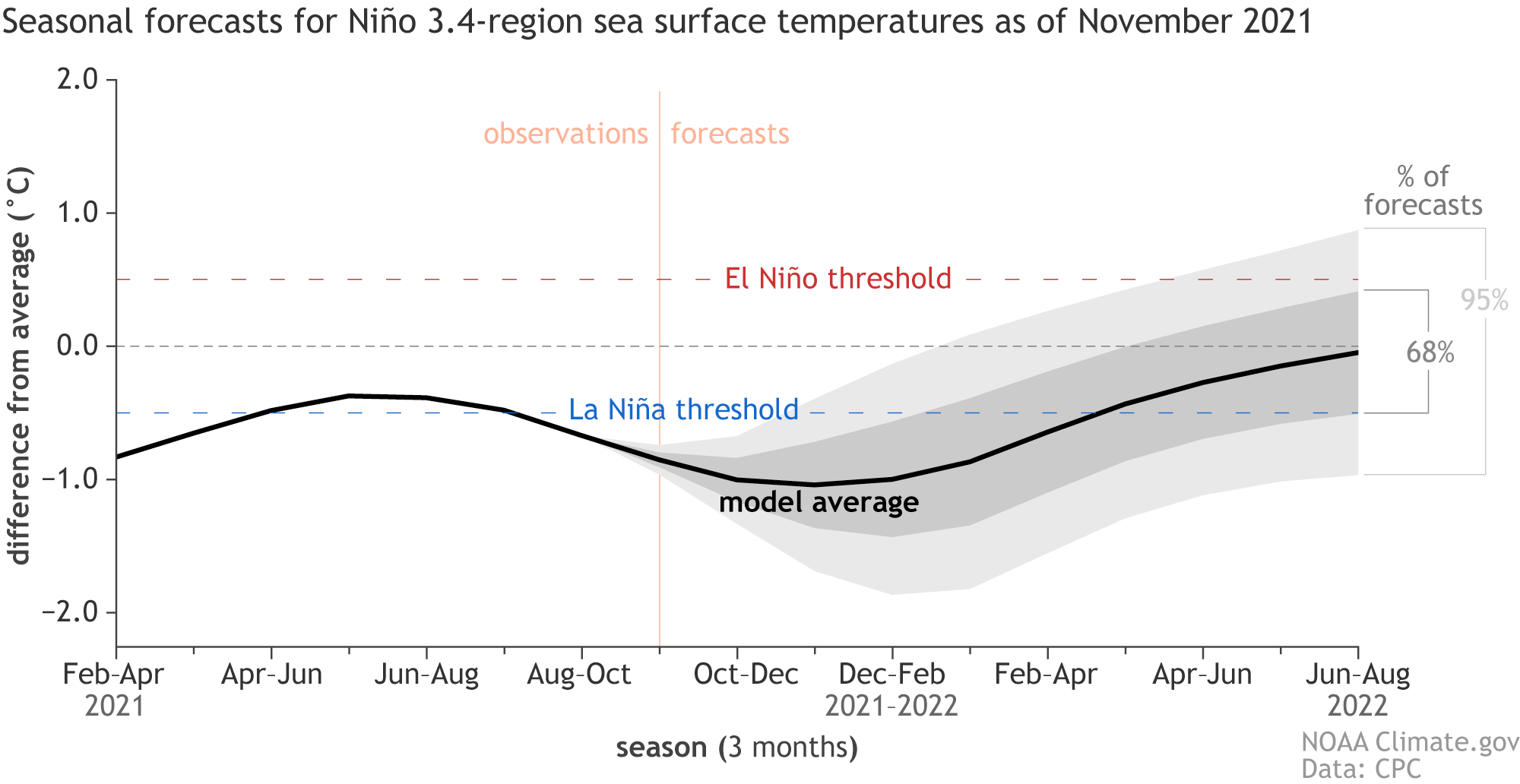
An interesting fact in the image in a higher place is that the current cold stage was post-obit the previous La Nina that weakened this Bound. Such an event is called a second-yr La Nina, where nosotros have two cold phases following each other.
Merely it is non unusual to take two La Nina events back-to-back. In fact, of the twelve first-year cold events, eight were followed by a second cold phase the side by side winter, two past a neutral phase, and two by El Nino.
The electric current cooling has been quite substantial and persistent from the beginning of the meteorological fall flavor. In the image below, nosotros take the sea surface temperatures in the main ENSO 3.4 region. We can encounter a steady temperature drop since September, reaching a bottom in tardily October and now in mid-December.

But we have to remove the normal temperatures, to see the actual cooling, and the cold anomalies. The image below shows the temperature anomaly in the ENSO 3.4 region and reveals a stronger divergence from the norm since mid-September, due to stronger merchandise winds. Peak anomalies were reached in tardily October, with some other driblet-off in December.
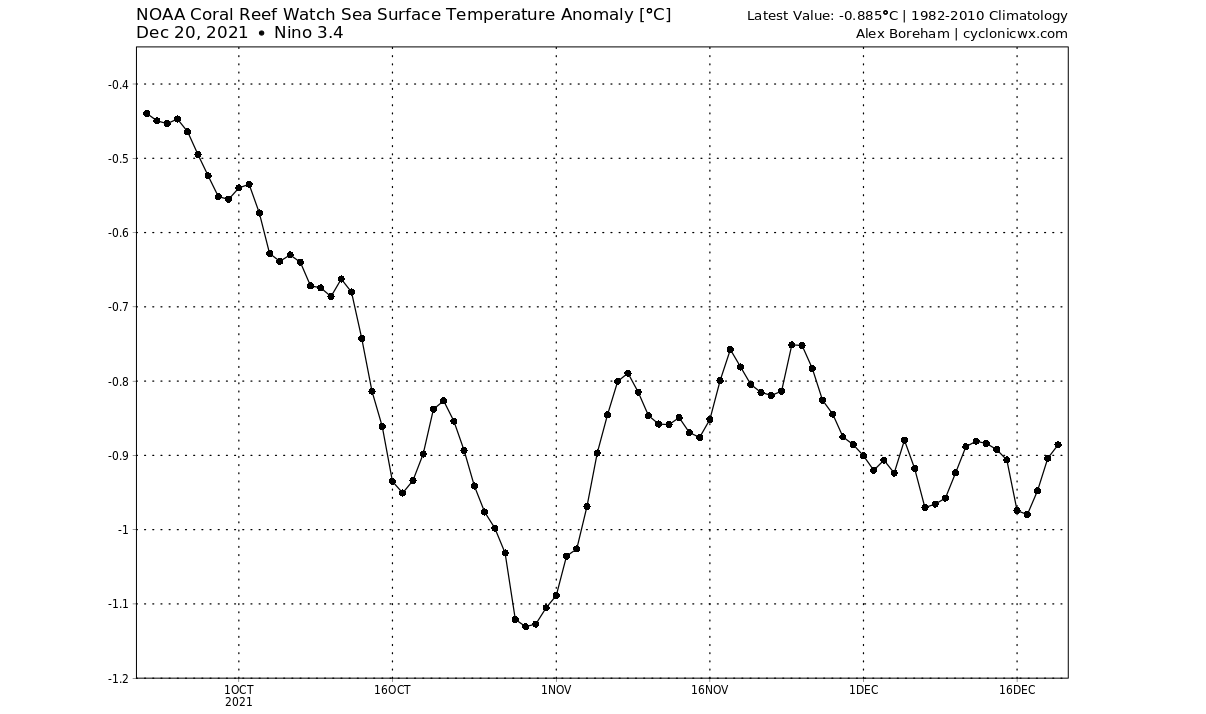
Below we have a shut-up prototype of the ENSO regions. You can nicely come across the developing cold "waveforms", as the pressure patterns are creating strong trade winds. They drive the wind-driven ocean surface cooling. Peak cold anomalies are now focused more towards the eastern regions.
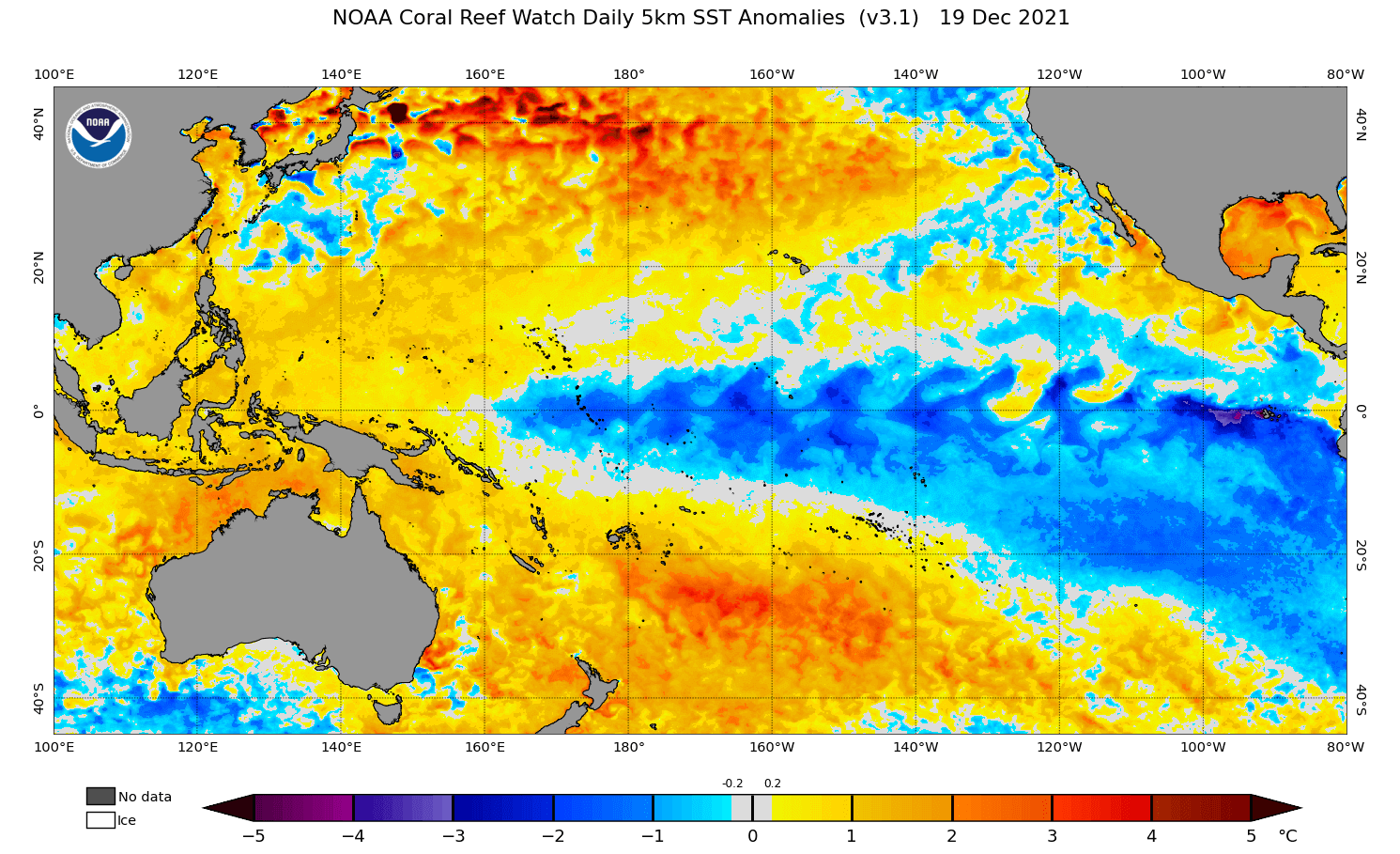
If we look at the actual current temperatures, they reveal a "cold natural language" extending from S America, towards the west, directly across the equator. In this region, the surface waters are ever colder than the surrounding regions, but during a La Nina event, they tin be up to 4°C colder than normal. We can encounter the typical wind-driven surface cooling pattern.

Looking at the latest high-resolution assay by depth nether the ENSO regions, we however see colder than normal temperatures below the surface. A cold anomaly pool is sitting 100-250 meters below the surface, with colder anomalies closer to the surface in the eastern regions. This shows that the upwelling is stiff there, due to strong merchandise winds.

One way to expect at the whole ENSO region temperature strength is by looking at the ocean heat content. This besides takes the water at depth into consideration, not only the surface temperatures.
And below nosotros can meet the La Nina of last year weakening in Spring. But the common cold anomalies take returned and too peaked in mid-October. Lately, the subsurface cold anomalies have weakened, indicating that the La Nina is probable at (or past) its peak.

Based on all the available data, an official La Nina watch is still in upshot, released by the NOAA's Climate Prediction Heart:
"La Niña is favored to continue through the Northern Hemisphere winter 2021-22 (~95% adventure) and transition to ENSO-neutral during the bound 2022 (~60% risk during April-June). La Niña is predictable to affect temperature and precipitation across the United States during the upcoming months."
Tracking the weather furnishings of these ENSO phases is not all that easy. Information technology is non as unproblematic to just signal at a certain conditions event and only call information technology "ENSO influenced". Global weather is a very delicate and complicated arrangement, where everything can have an influence on everything. Only of course at quite different temporal and spatial scales.
For instance, it is quite simple to find show for directly La Nina or El Nino-related atmospheric condition patterns over the North Pacific or the United states of america in winter or spring.
But over Europe, the direct La Nina influence slowly fades, due to the generic weather blueprint variability. The influence is still at that place, just it is typically highly mitigated/modified by the existing atmospheric condition patterns in the N Atlantic.
ENSO SEASONAL FORECAST 2022
You lot now know what ENSO and its warm and cold phases are. So we are going to focus on its evolution through the current wintertime flavour and see what the virtually contempo forecasts show for 2022.
Below we have the ocean temperature forecast for the 2022 role of the electric current winter flavour, from combined multiple global seasonal models. It shows a fully adult La Nina beyond the equatorial Pacific Ocean. At this point, it is already past its peak cooling, with the common cold anomalies expected to reduce further into jump. The atmospheric condition effects, withal, can concluding a while longer.
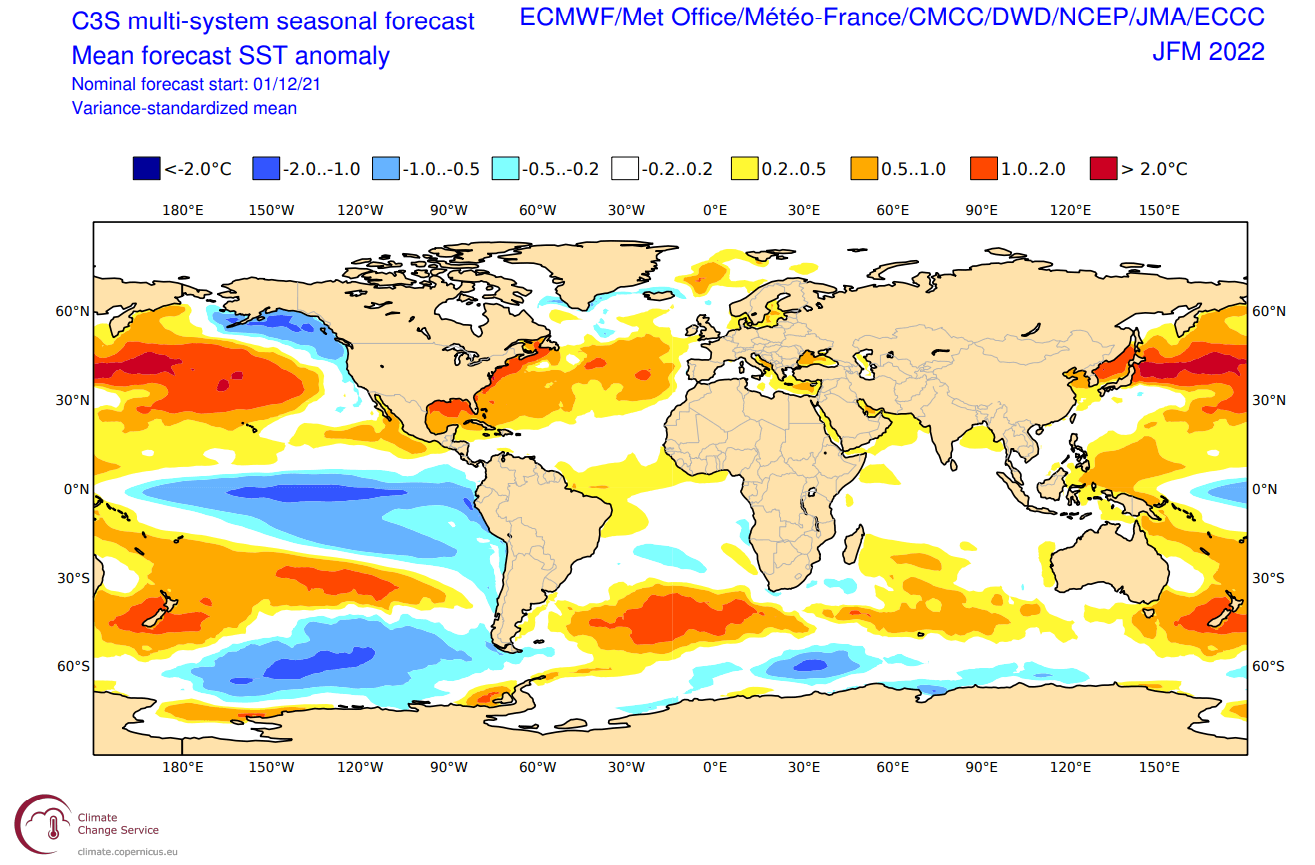
The ENSO analysis and ensemble forecast below from ECMWF shows that La Nina began to quickly develop during late Fall, reaching pinnacle cooling in early on Winter. The forecast does show a quick return to neutral conditions in Spring, with a reduction of negative anomalies. If it continues, this could lead to a new warm phase (El Nino) in late 2022.
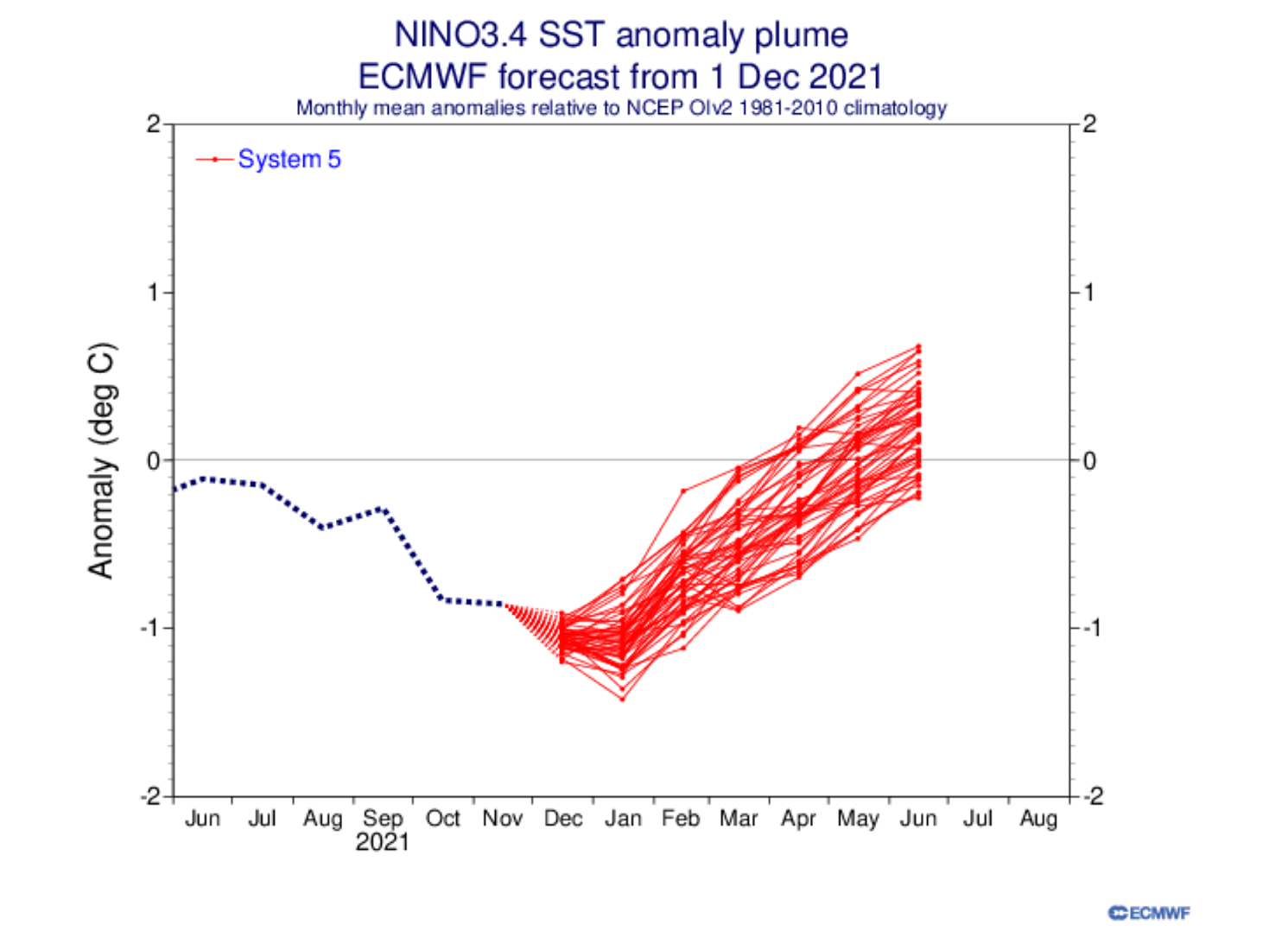
The ENSO forecast from the The states CFSv2 model shows the current peak cooling in this month. Simply information technology as well shows a forecast for a slower return to neutral atmospheric condition over Spring, compared to the ECMWF. Going into Summer 2022, there is an increasing gamble of a warm phase (El Nino) starting to develop.
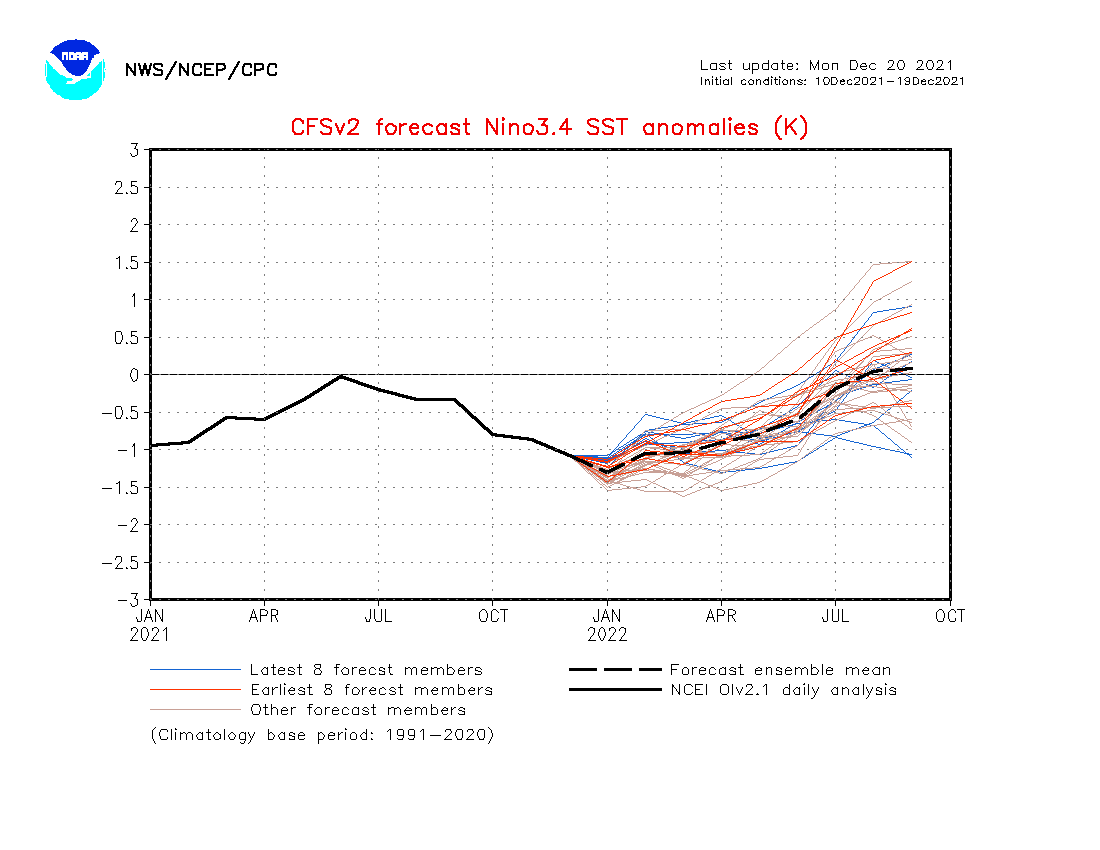
The CPC/IRI official probabilistic ENSO forecast shows the current La Nina lasting over the winter season into Spring 2022. What is interesting is the transition into summer, where we do run across the chances of an El Nino increasing, simply like on the model forecasts above. It is typical for a new phase to emerge in the summer/fall season, so seeing increasing El Nino chances during the Summer side by side twelvemonth, is the expected first sign of a alter.

The image beneath is a consolidated analysis and forecast epitome from multiple N American seasonal models. It also shows the La Nina reaching the coldest phase this early winter season. Just going ahead into 2022, nosotros see a return to the neutral phase (between 0.5 and -0.5), with an increased chance of an El Nino developing later in 2022.

It also shows neutral weather for next Summer. But information technology is unlikely to have a third-yr La Nina, so chances are better for an El Nino emerging, compared to having another cold consequence.
The most recent ECMWF extended seasonal forecast actually shows the developing warm stage (El Nino), starting around Summer 2022. ECMWF releases these extended seasonal forecasts every few months. The adjacent extended forecast cycle is coming in Feb 2022, which volition give a much better picture of what to wait for the next Autumn/Winter season.

Nosotros now know that an El Nino is likely coming in 2022 and especially during the next winter season. So it'south fourth dimension nosotros await at how an El Nino actually differs from a La Nina both in the Ocean and in the Atmosphere.
LA NINA OR ELNINO
To fully sympathise the ENSO, we must sympathize both its phases. The forecasts are hinting at the emergence of an El Nino in 2022. This is why nosotros will await at the main divergence and the typical weather influence of the El Nino versus a cold La Nina phase that we are currently in.
On the paradigm below nosotros have a directly comparison between the sea temperature anomalies during an El Nino and a La Nina. Both examples prove realistic data, from the 10 strongest events for each stage.

Typically, an El Nino develops stronger anomalies, which are focused more than on the eastern regions. Merely while La Nina has weaker boilerplate anomalies, they typically peak more towards the central ENSO regions.
Beneath we take two real analyses of body of water temperature anomalies. First is the strong La Nina from last year, and the 2nd is the strong El Nino event during the 2015/2016 winter season.
We can run across a completely opposite motion picture and two unlike patterns over the aforementioned expanse of the ocean. Cooler than normal bounding main temperatures during a La Nina, and warmer than boilerplate temperatures during an El Nino. As we will run into later, their influence on the atmospheric condition is also almost very much the opposite.
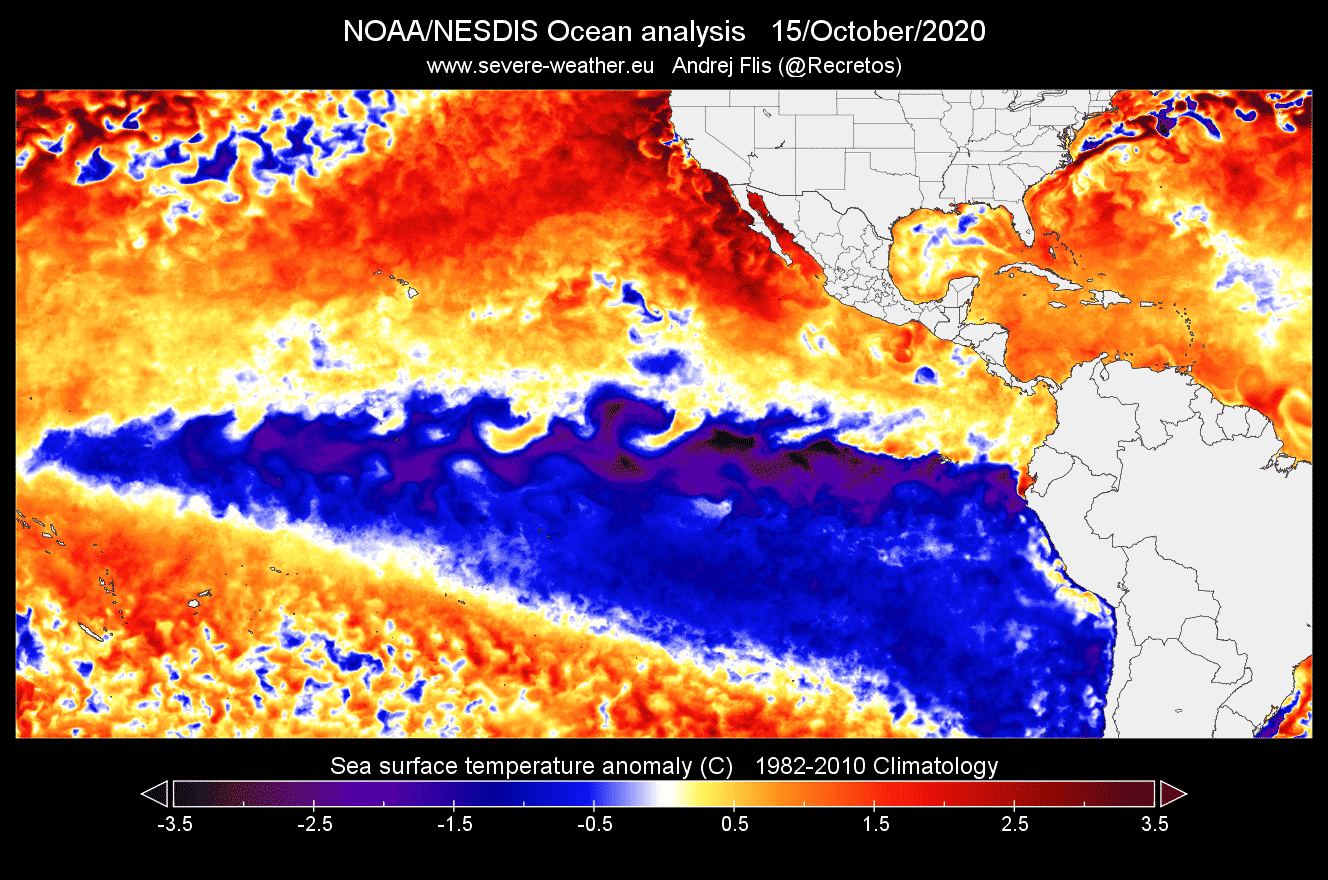
Below is the El Nino event during the winter of 2015/2016.

But besides the temperatures, ane of the main differences can of course be institute in the tropical pressure patterns. During an El Nino, the pressure over the tropical Pacific is lower, with more than rainfall and thunderstorms.
But during a La Nina, the pressure level over the equatorial Pacific is loftier, creating stable weather condition and less precipitation. This patently translates into the global circulation over time, affecting the weather seasons on both Hemispheres.
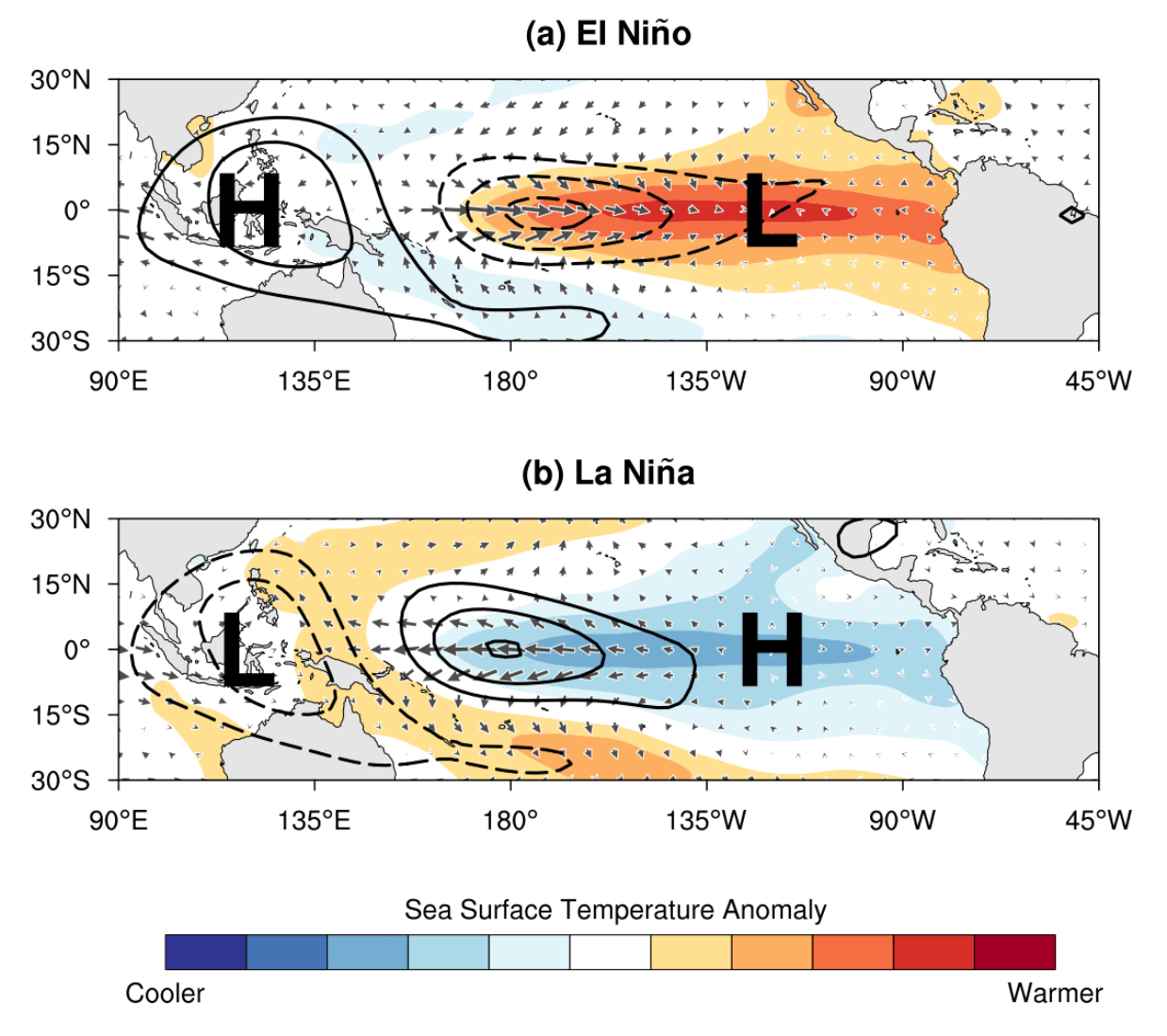
Looking at the actual temperature instead of the anomalies tin likewise help to run across a large divergence between the 2 phases. The first image below shows the sea surface temperatures during a La Nina. The second prototype shows the body of water surface temperatures during the strong 2015/2016 El Nino event.
Obvious again is the "cold stream" of cooler ocean waters during a cold phase, which is driven past the stronger easterly trade winds. The body of water temperature departure between the La Nina and El Nino can be quite large, upwardly to 10 degrees Celsius in some places.
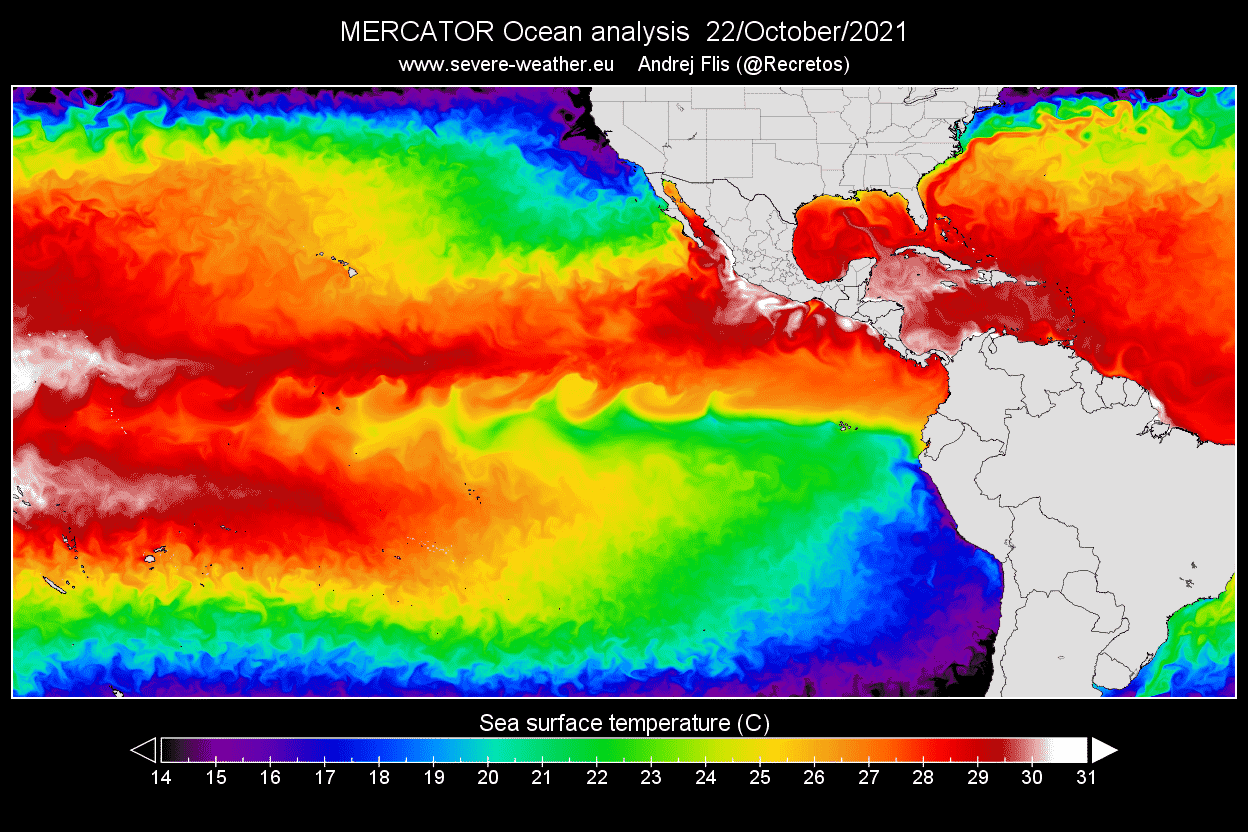
You can briefly encounter a very weak "cold stream" also in the warm phase beneath, but it is very suppressed and hardly noticeable. This cold stream is actually normal due to persistent easterly trade winds. Only it is much stronger during a La Nina and much weaker during an El Nino, due to pressure changes affecting the intensity of these easterly winds.
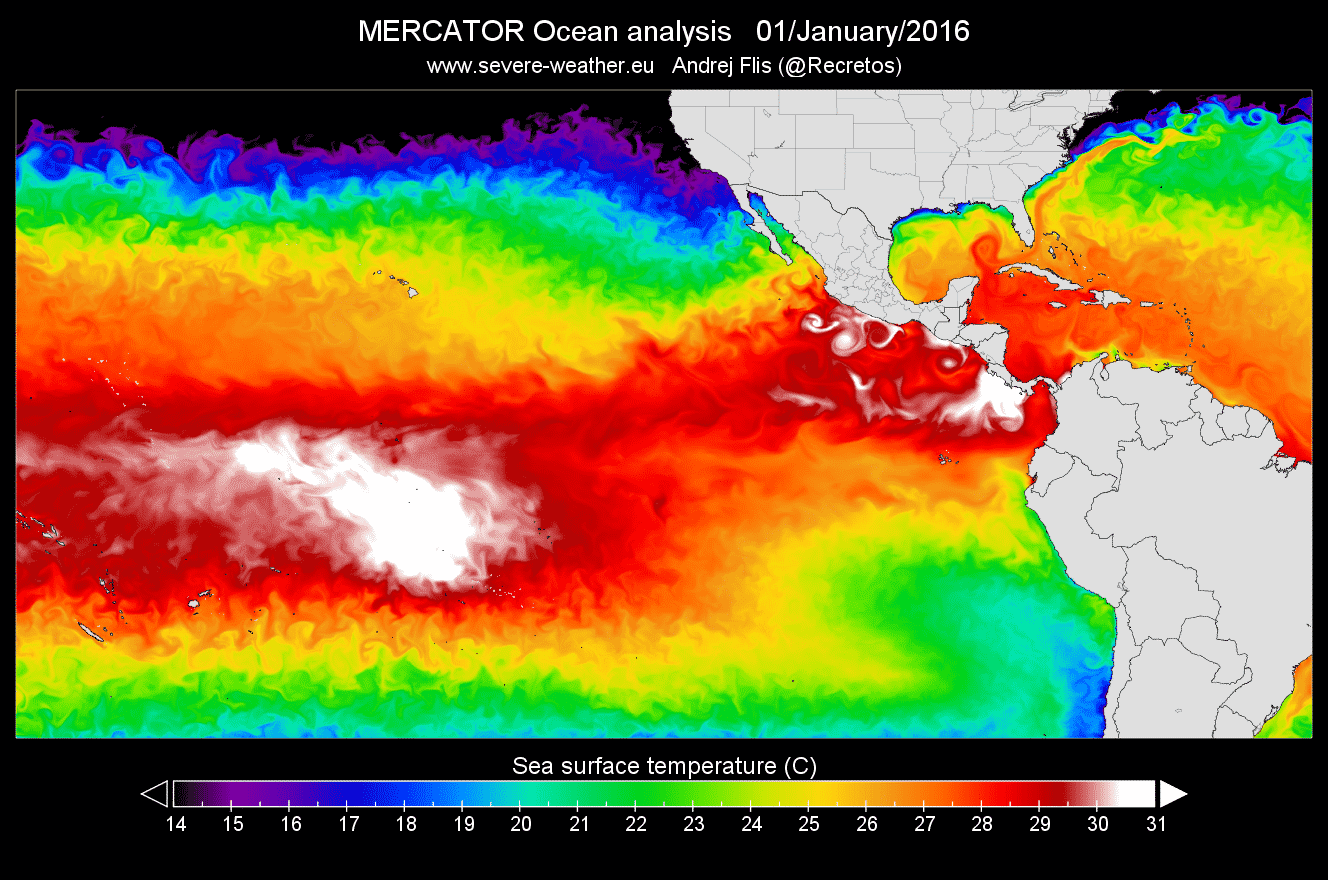
Strong trade winds are also important because they affect the food chain beyond the tropical Pacific regions and on both American continents. Strong trade winds mean that deeper and cooler water rises up to the surface, replacing the water that was "pushed away" by the winds.
This process is known as "upwelling." Substantially this is a vertical transport process, every bit shown in the image beneath, which helps to bring cooler waters and nutrients to the surface.
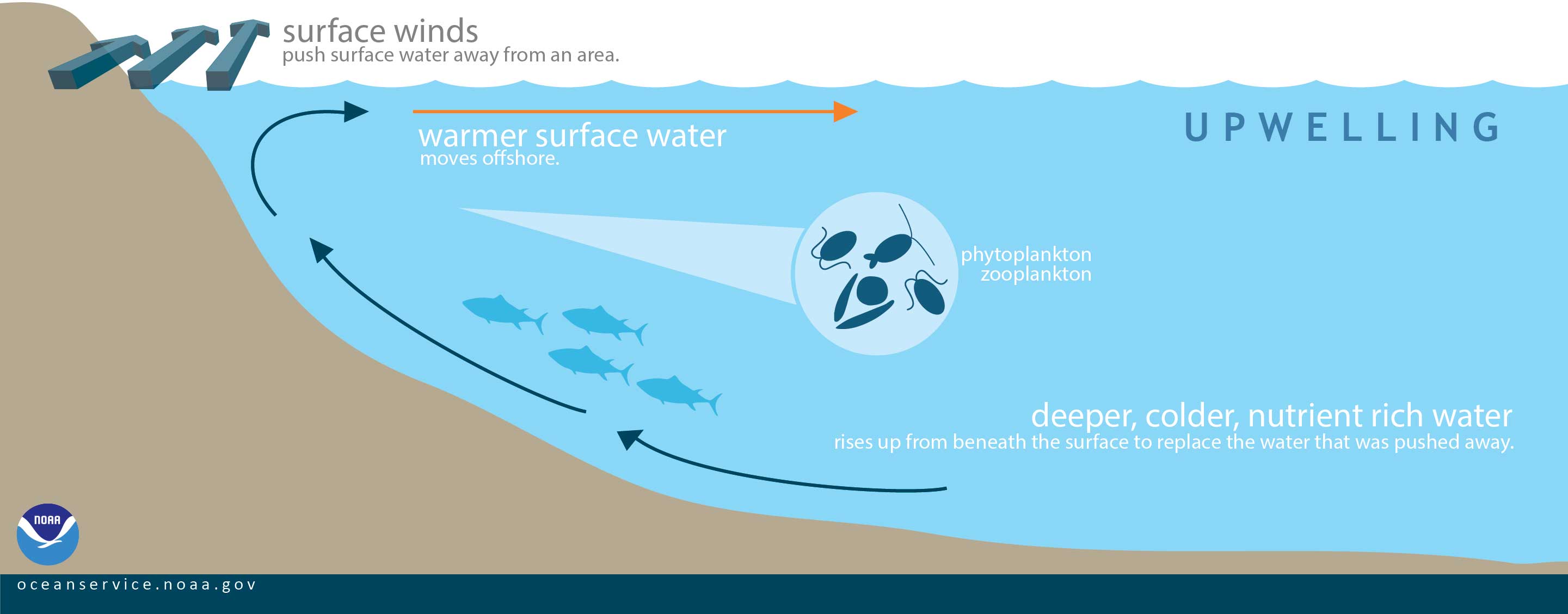
Water that rises to the surface as a result of upwelling is typically colder and is quite rich in nutrients. These nutrients can "fertilize" the surface waters. This means that these surface waters often take high biological productivity.
Nosotros can run across this upwelling result straight when comparison the temperature by depth during a La Nina and an El Nino event. The first image below shows the h2o temperature past depth during the 2015/2016 El Nino event. We tin can see much warmer waters in the upper-oceanic layers, and cooler waters staying deeper down, as they cannot rise on their ain.

But the subsurface assay of the electric current La Nina result shows a much different motion picture. Yous tin can nicely see how the 20°C threshold is much closer to the surface in a La Nina event. This is due to the upwelling effect, as the trade winds cause the deeper colder water to rise closer to the surface.
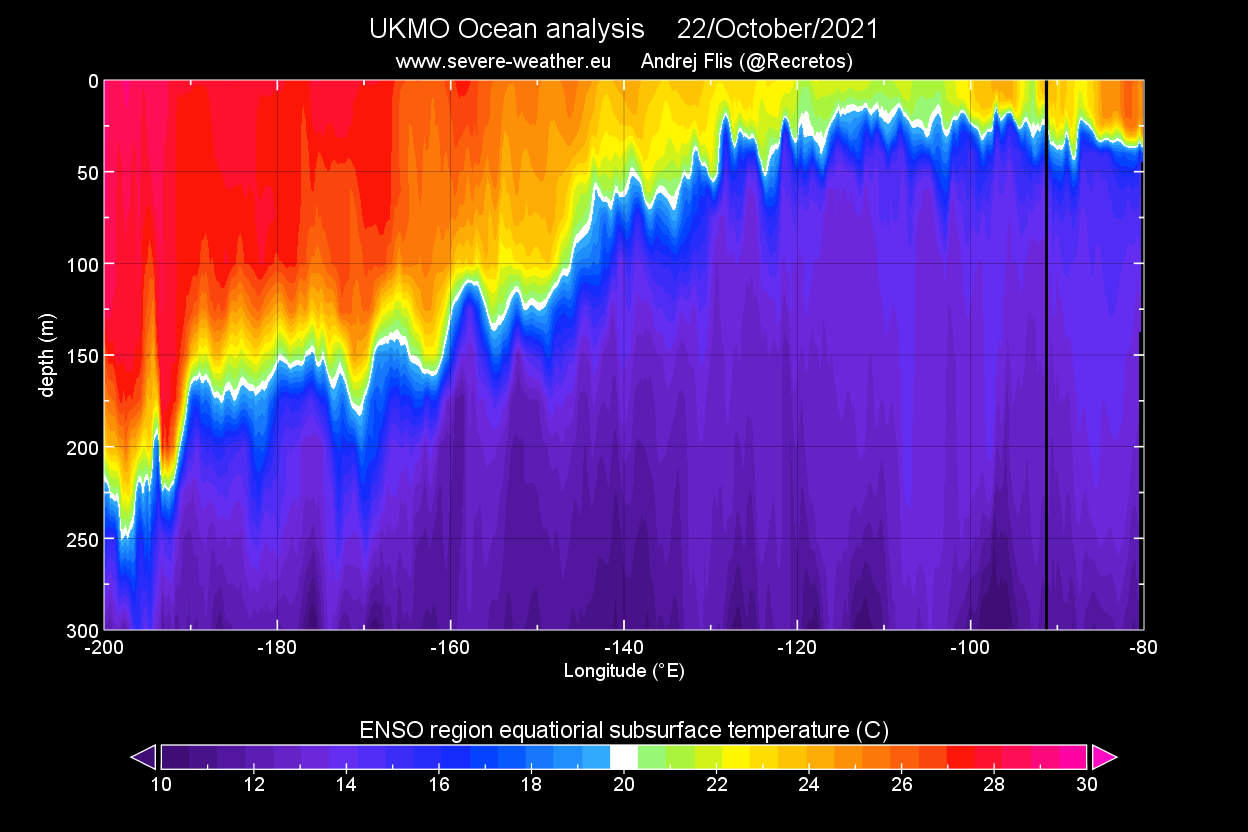
The layer between the warmer and colder waters is called the "thermocline". This is a sparse layer in the ocean, where the temperatures start to drop significantly. It basically separates the upper warm and deeper common cold layers.
During an El Nino, seen in the image below, the thermocline layer is pushed deeper down. That is due to the warmer waters from the west entering the region, warming the upper-ocean layers.

Dissimilar Weather OF THE ENSO PHASES
Here we take to add together a very important "disclaimer", that an ENSO phase is not only a pure "influencer" for our weather. It can likewise be viewed and interpreted equally one of the responses to the overall global state of the atmosphere and bounding main circulation.
Simply similar a warning light on the dashboard of a car, the ocean anomalies can tell us what is going on with the global circulation above and below the surface. But generally, ENSO does exhibit an important influence on the Jet stream in the Pacific Sea, and consequently also downstream and upstream around the world.
The jet stream is a large and powerful stream of air (wind) at around 8-11km (five-7mi) distance. It flows west-to-due east around the unabridged Northern hemisphere, affecting the force per unit area patterns and their development, directly shaping our weather at the surface.
Below is an example of the jet stream in winter at the 300mb level (9km/v.6mi altitude). In this example, the jet stream is curved quite far down over the central Usa, which brings colder air down from the north/northwest. It is curved upward over northwestern Europe. Such formation brings colder weather to the central United states and stormy weather to the Britain and Republic of ireland.

Comparison the two phases of the ENSO on the next paradigm below, we can see that they typically produce an entirely dissimilar jet stream pattern across North America. We will focus on this region every bit here, the ENSO has a major/direct influence on the position of the jet stream over the continent.
La Nina features a stronger and extended polar jet stream from Alaska and western Canada down into the The states. But the El Nino features a stronger Pacific jet stream and an amplified tempest track over the southern Us.

LA NINA WEATHER PATTERN
Looking closer at the La Nina weather condition signature below, we can see that its chief feature is a strong and persistent high-force per unit area organisation in the Due north Pacific. That usually bends the jet stream from the northwest down to the southeast, creating a colder due north/warmer due south weather pattern over the United States.
Alaska, western Canada, and the northern United states typically get a colder than normal winter, with more than precipitation. Southwestern and the southern Us usually experience warmer and a chip drier conditions during a La Nina winter flavour.
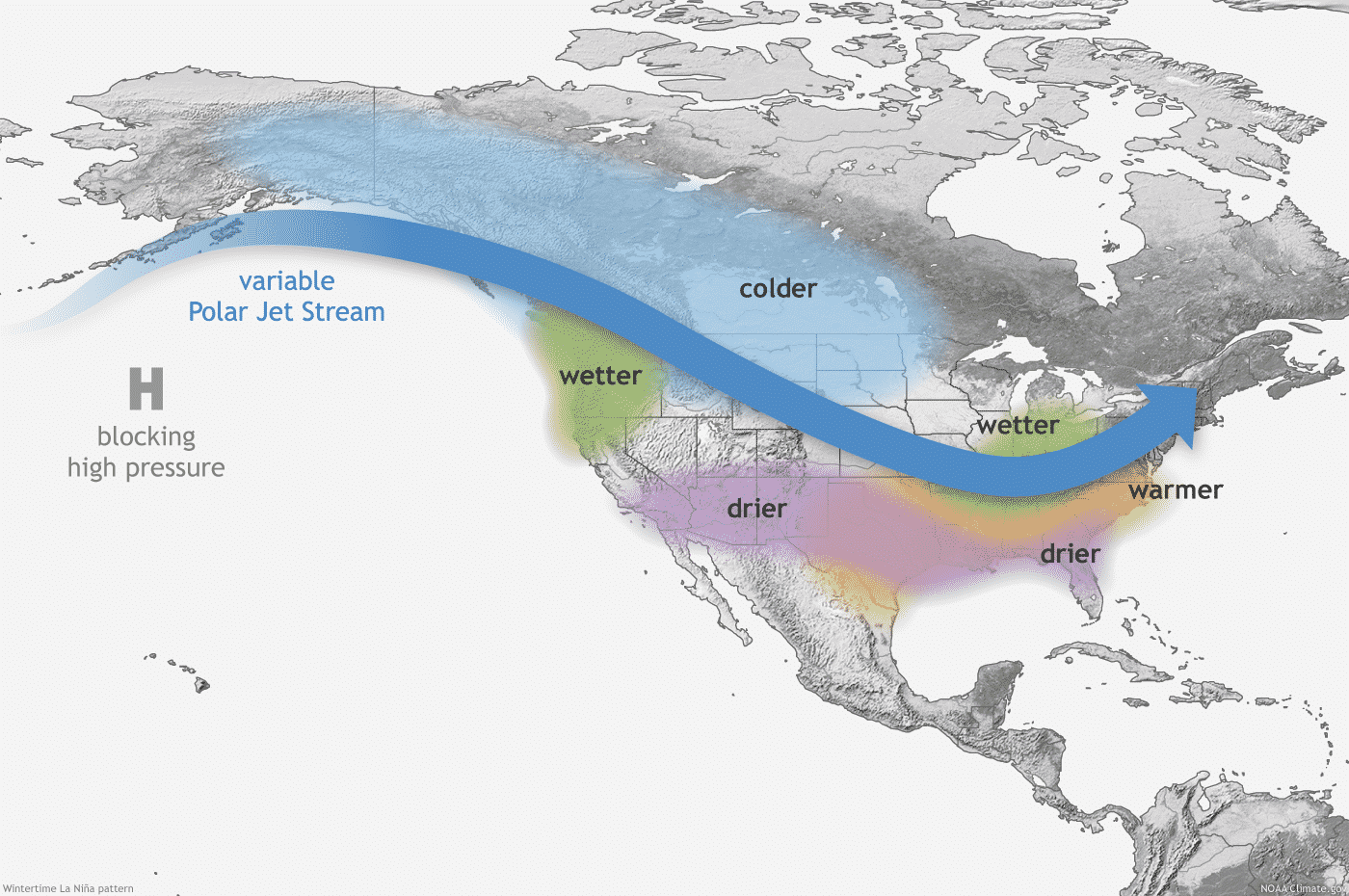
Changing the jet stream also means irresolute the snow potential over the continent. The colder air is more hands attainable to the northern United states of america, which also means that it has an increased snowfall potential during a La Nina winter. Especially areas like Alaska, western Canada, and the northern United States benefit from the jet stream above to produce weather condition patterns with more snow. The graphic below is by NOAA-Climate.
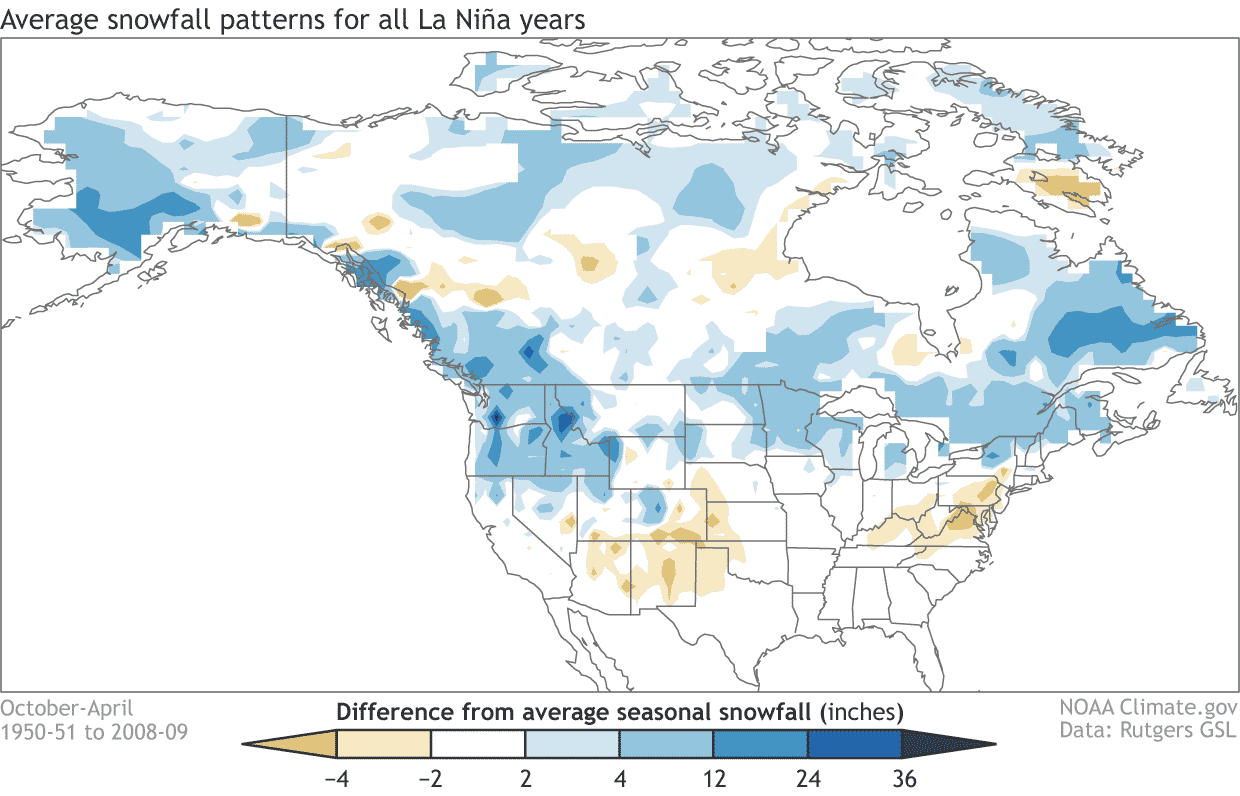
EL NINO Atmospheric condition Design
On the other hand, during the El Nino winter flavour, we accept a strong and persistent depression-pressure area in the N Pacific. That pushes the polar jet stream further to the north, bringing warmer than normal flow to the northern The states and western Canada. The southerly Pacific jet stream is amplified, bringing storms with lots of precipitation and libation weather to the southern The states.

Looking at the average snowfall for an El Nino winter, nosotros can see a much different picture than with the La Nina. At that place is less snowfall in the northern United States during the El Nino seasons. The weather are mostly warmer than normal and drier than normal in the due north. But there is more snow in the west-central United States and in the parts of the eastern United states, with cooler weather and more wet.

After passing Canada and the United States, the jet stream moves into the N Atlantic, where information technology can take unlike paths towards Europe. A lot depends on the overall apportionment pattern and the existing pressure systems in the N Atlantic. This is where ENSO by and large perhaps loses its straight influence over Europe, equally regional systems in the Atlantic interfere.
But it usually still has an of import influence, as it changes the position of the entering jet stream from the west. The incoming jet stream can merge with the systems in the Atlantic, helping to create a whole new atmospheric condition pattern for Europe.
Typically, the chief problem is that the final outcome is far more unpredictable in this zone than over North America, which feels a much more straight and predictable influence.
ENSO – The states TORNADO Flavour INFLUENCE
As history shows, La Nina can have an important influence on the Spring tornado season in the Us. And unremarkably not in a good way.
Going directly to the point, we have a very interesting image below from NOAA Climate. It shows a very nice comparison of hailstorms and tornado events during the bound flavour in the United states, compared between El Nino and La Nina years.
It is quite interesting to run across, that in a La Nina spring season, there is a substantially higher frequency of hailstorms and especially tornadoes in the southern and southeastern parts of the The states. It nicely shows the master outlines of the key and eastern parts of the Tornado Alley.

Tornado Alley is a nickname given to an area in the southern plains of the central Usa, that consistently experiences a high frequency of tornadoes and other astringent weather condition events each twelvemonth from late winter to late spring.
But why are there more than tornadoes and other severe weather in the southern United States during a La Nina?
Information technology mainly has to exercise with the weather patterns we have seen earlier above, forced past a La Nina event. Equally La Nina promotes a loftier-pressure system in the North Pacific, that commonly corresponds to the pressure drop over western Canada and the northwestern United States.
This can act as a source region for frequent cold fronts, which motility from western Canada down towards the south-fundamental United States, where they meet warm moist air coming up from the Gulf of United mexican states. Together with the shifted jet stream over the U.s., this usually produces a very volatile combination with a lot of available energy for the storms to become astringent and tornadic.
Beneath is a graph that shows annual tornado numbers in the United states from 1954 to 2014, which is a very proficient sample size. Looking over the years, we can see that from the top five most active tornado years, 4 were La Nina seasons. At least during the leap, where the ENSO still has its presence in the global apportionment, coming out from the winter flavour.
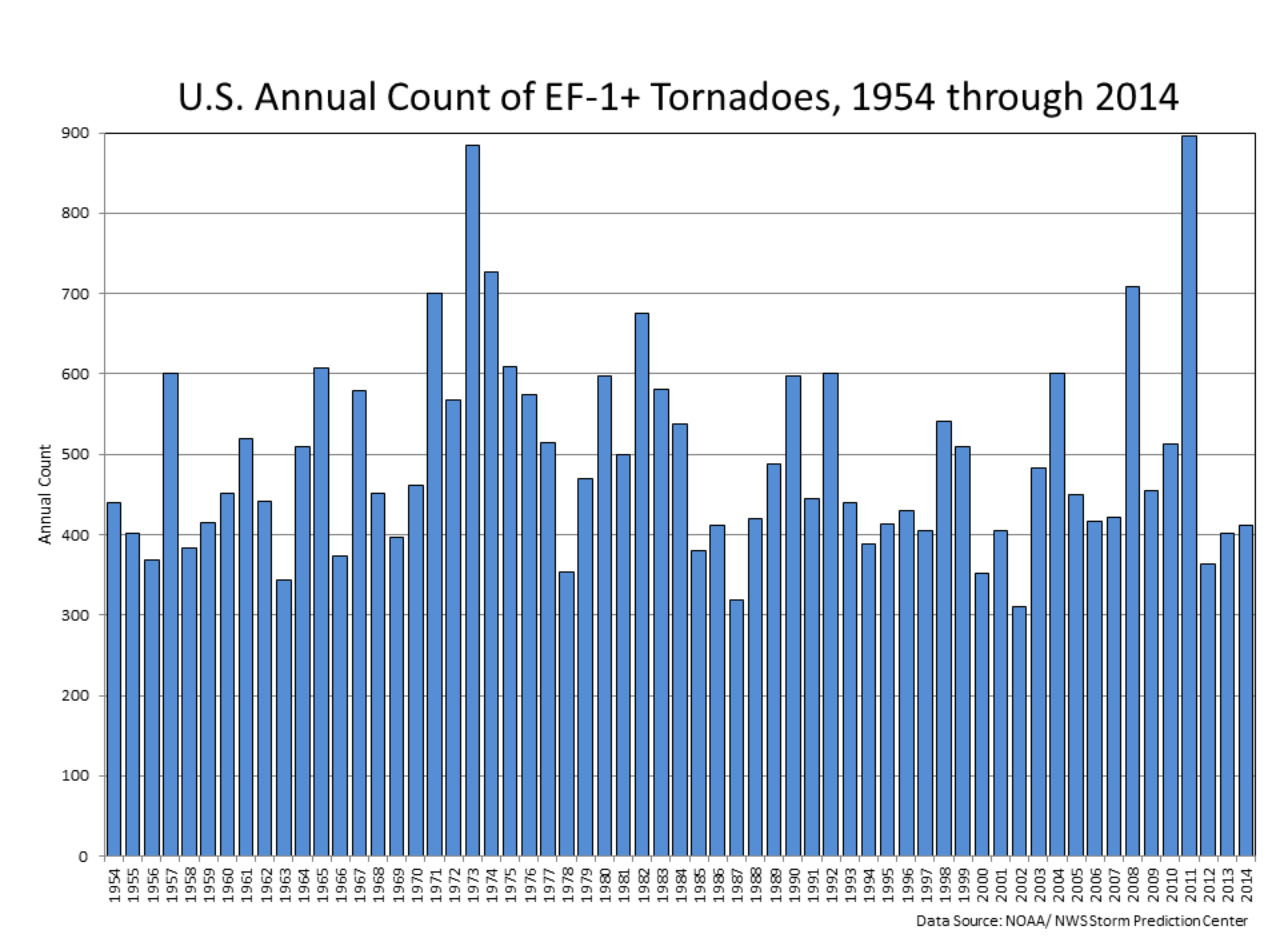
LA NINA 2022 SEASONAL Weather INFLUENCE
We have seen that the main feature of La Nina winters is a strong high-pressure system in the North Pacific. Below we have an paradigm that shows the boilerplate winter force per unit area pattern from multiple La Nina winters. The main characteristic is of course the high-pressure arrangement in the North Pacific and low pressure over Canada.
That is the typical signature of the cold ENSO phase. Over Europe, we see lower pressure over Scandinavia and college pressure over northwestern Europe, but that cannot be designated as a typical atmospheric condition response from the La Nina.
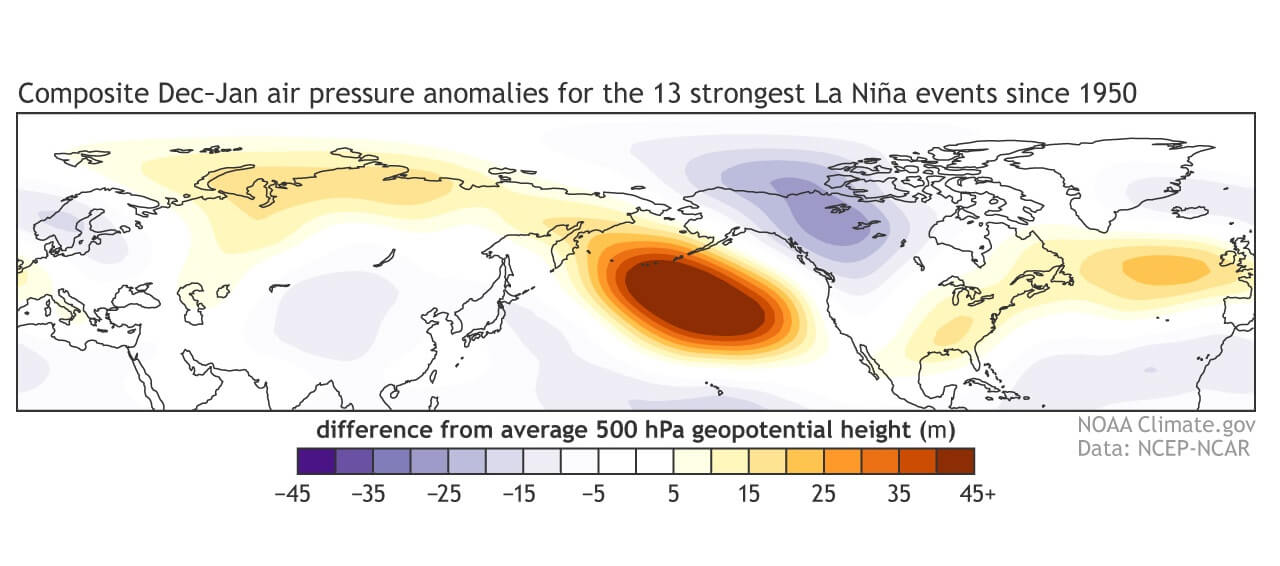
The chief takeaway is the strong high-pressure arrangement in the Northward Pacific and lower pressure over western Canada and the northwestern United states of america. That sends the polar jet stream downward over the northern United states of america. We take seen that on the previous images higher up, which is the typical La Nina weather response if there are no other potent external factors.
We volition speedily extend our wait into the seasonal trends for early 2022, using the ECMWF forecast. The catamenia in question is the January-February-March season.
That ways that the first Leap month is also included in the forecast. But since the wintertime months have typically more powerful patterns, the signal from March typically has a weaker contribution to the boilerplate.
At this point, nosotros have to add together an important piece of information. Seasonal forecasts similar the ane beneath, typically show a good groundwork forcing and large-scale dynamics. But in one case in the bodily weather season, we ever have a lot of sub-seasonal variabilities, from different sources.
Below on the epitome from a climate study, you tin encounter different weather phenomena, and how they rank on size and temporal scales. Large-scale factors similar the trade winds and ENSO and climate variation tin be nicely accounted for in the seasonal forecasts. But as we go to smaller sizes and shorter time scales, there is influence from frontal systems hurricanes, thunderstorms, etc,…
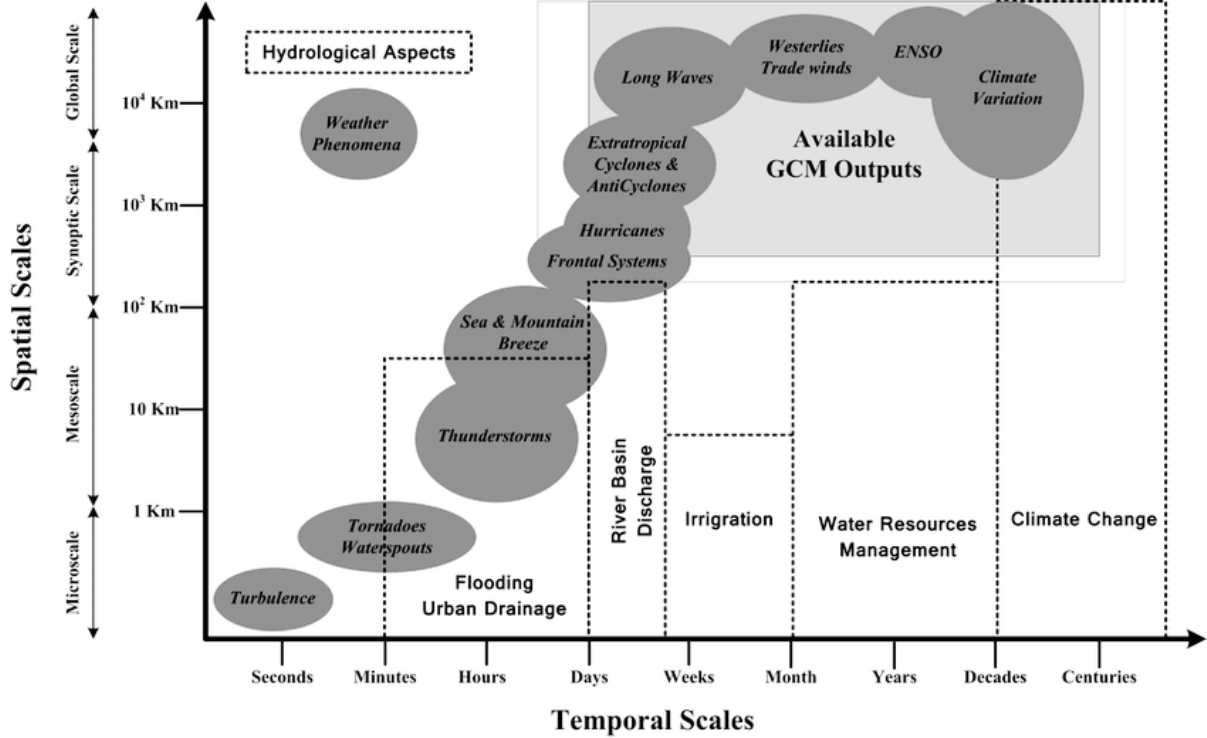
These smaller scales are harder to recoup for in the seasonal models, and then they are typically the chief source (if strong plenty) for the difference betwixt the long-range forecast and the final actual weather.
Merely, the long-range models do also include these processes to some degree of predictability, every bit they do simulate the entire global weather organisation. The problem is only that the smaller the size of the weather phenomena, the harder it is to forecast it on a seasonal scale.
We have a very nice example this month, equally for case, Europe is generally experiencing a colder and snowier first month of winter than expected. Over North America, the temperature design was predicted well for December, as the influence of the ENSO is stronger here, exerting its influence.
Early 2022 SEASONAL FORECAST
Now going to the latest forecast data, information technology was issued earlier this month by EMCWF. Equally nosotros can see below on the pressure pattern forecast, the strong loftier-pressure level system in the North Pacific is nevertheless present. That is the fingerprint of the La Nina and is likely to stay present well into the early Jump flavour. Notice the much lower pressure over most of Canada, curving the jet stream into the northwestern United states of america.
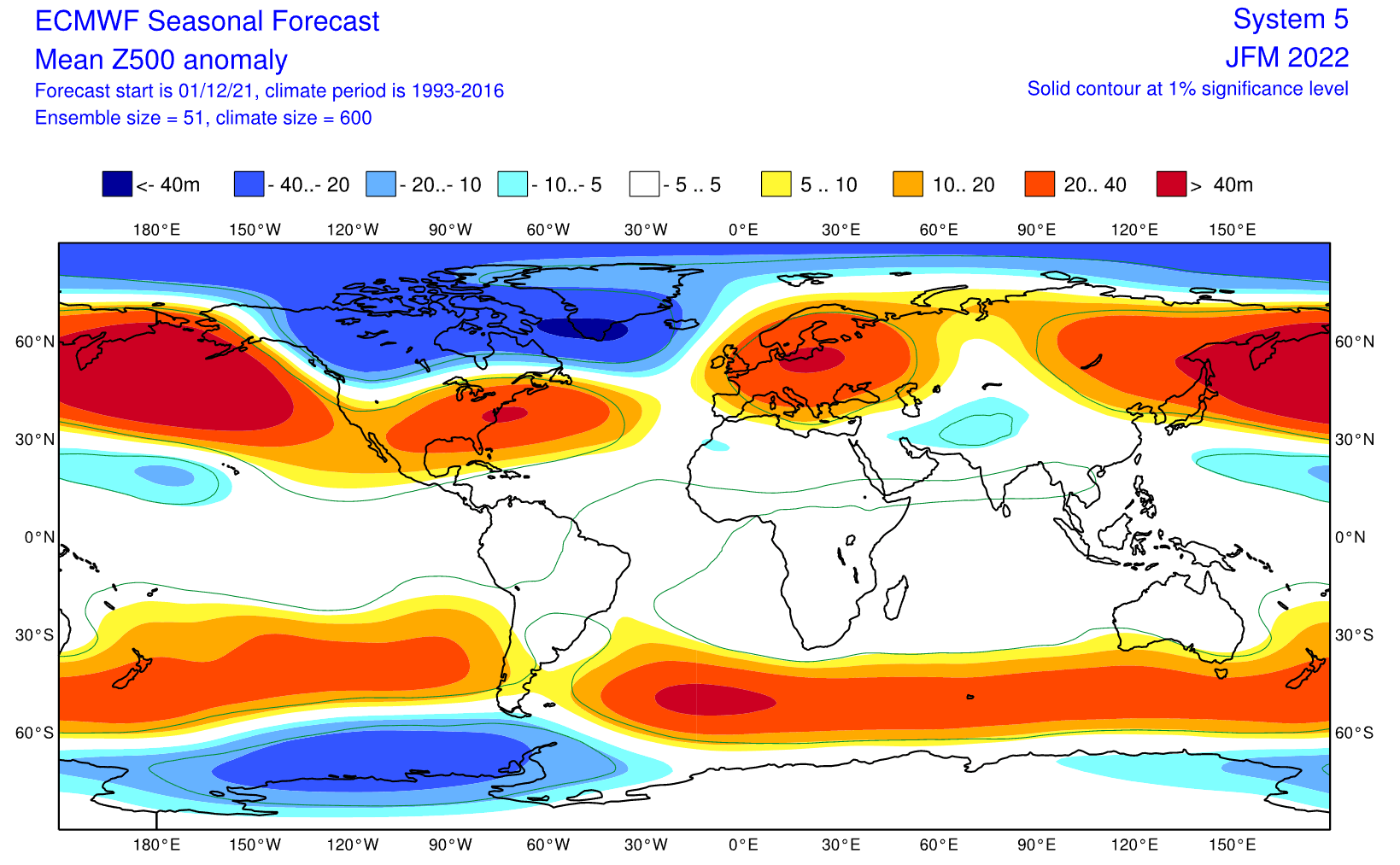
Lower force per unit area extends into Greenland, keeping the jet stream more than the northward, and assuasive a high-pressure expanse to expand over much of Europe.
Looking at the global airmass temperatures, we see the strong common cold pool in western Canada. That is forming this month and is prepare to stay till the end of the wintertime season. Y'all can notice the warmer temperatures over much of Europe, which would advise a pattern change to a more than westerly menses in early 2022.
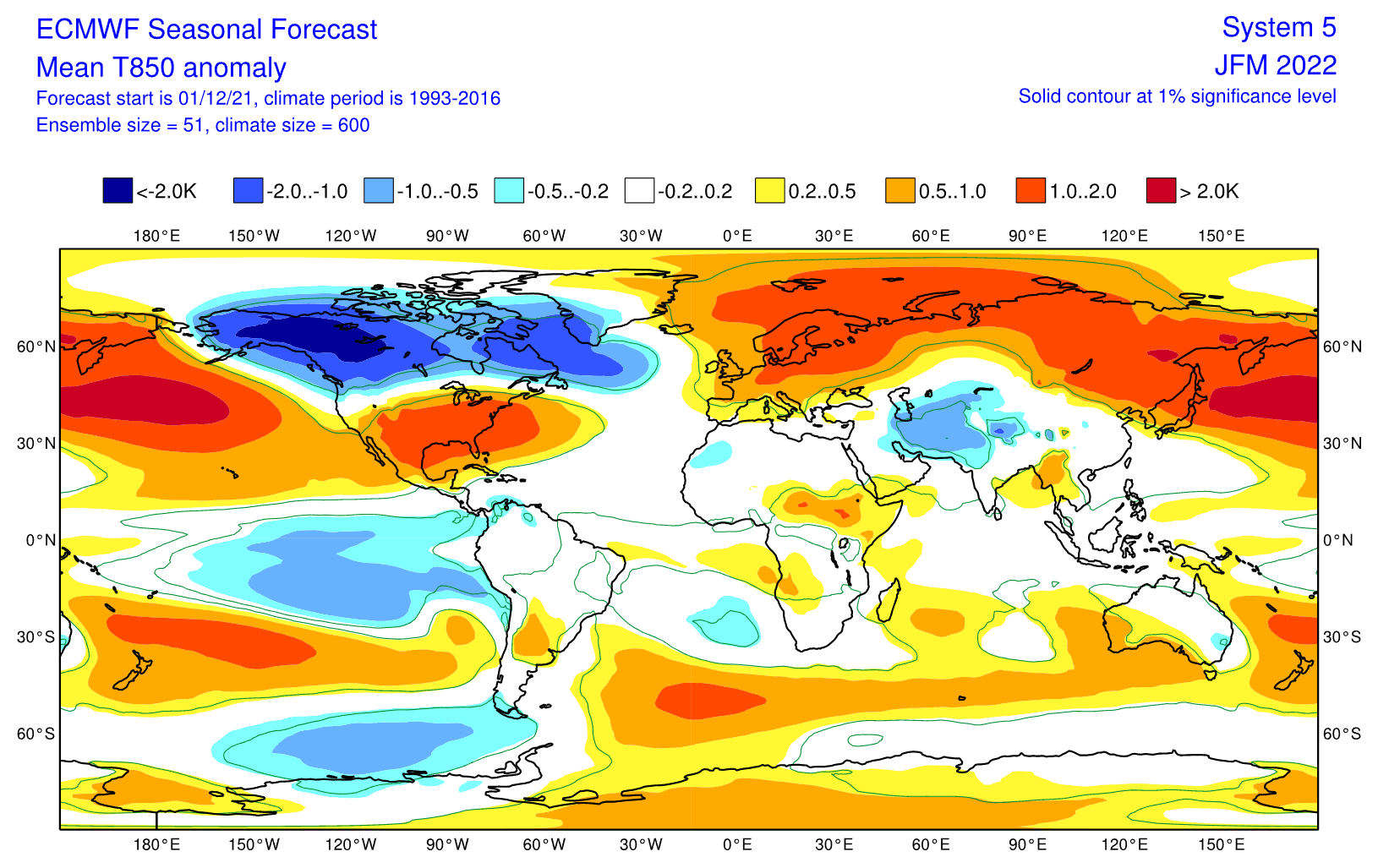
Taking a closer look at Europe, the surface temperatures are by and large above normal over the n and northeast. In that location is however a neutral zone in parts of central Europe, suggesting that colder air intrusions can continue in January and February.
That is like to what we have seen at present in December, but with a reduced frequency. These forecasts merely show the prevailing or average picture show over the course of 3 months, which can contain a lot of sub-seasonal variabilities.
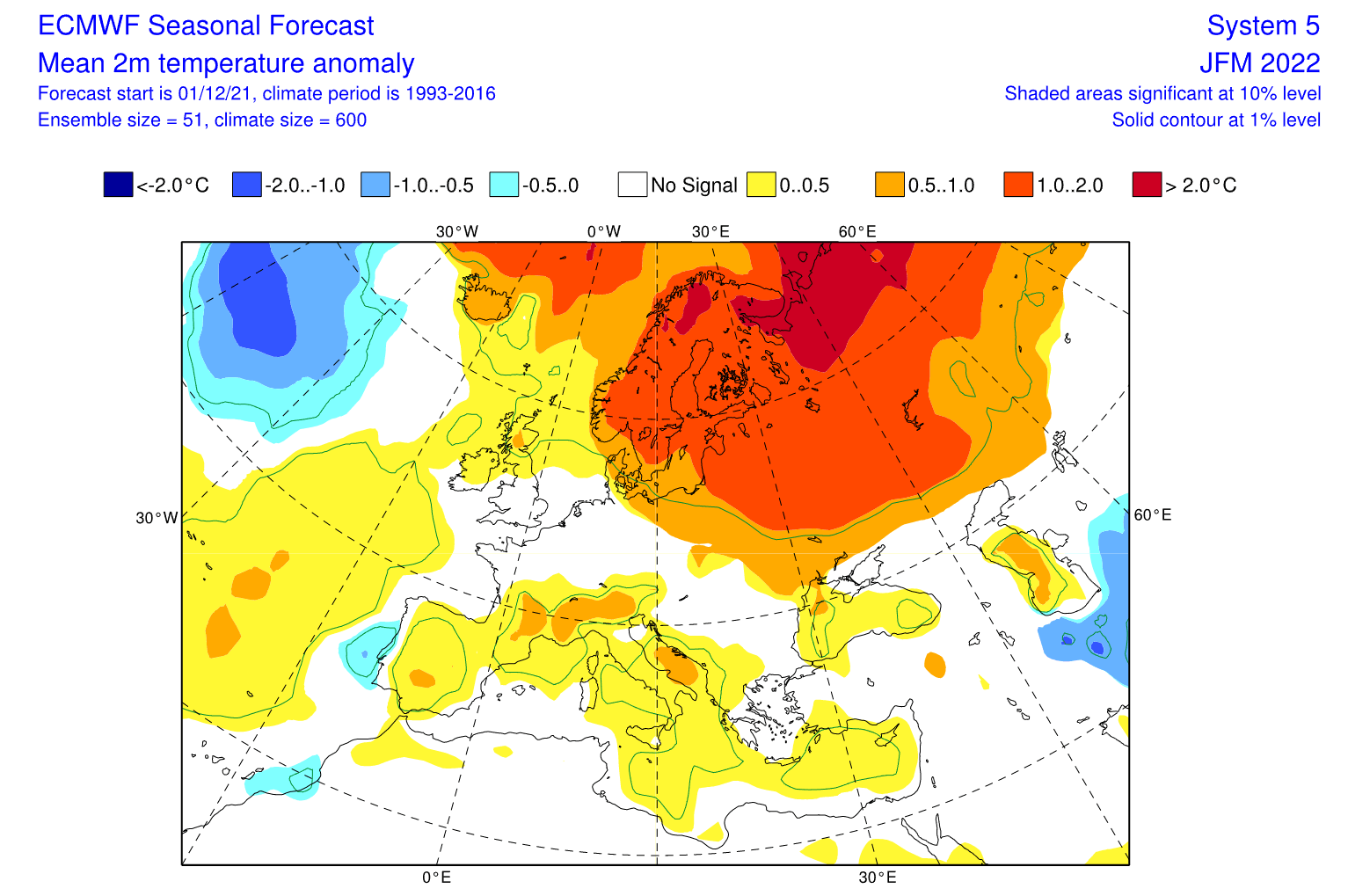
Over North America, we see the large cold pool over western Canada and Alaska. That comes from the due north flow around the potent blocking high over the North Pacific. In this blueprint, common cold air can then rapidly spread into the midwest and the primal United States, every bit we accept seen this month already, despite warmer than normal weather beingness forecast in the boilerplate.

Looking quickly at the global precipitation forecast, we come across mostly drier than normal conditions over Europe, under a high-pressure system. Over N America, more precipitation is forecast over Canada, which is mainly snow. More than precipitation is as well forecast over the northwestern and northeastern parts of the United states of america. The southern U.s. is forecast to have normal to drier weather, typical for a La Nina season.
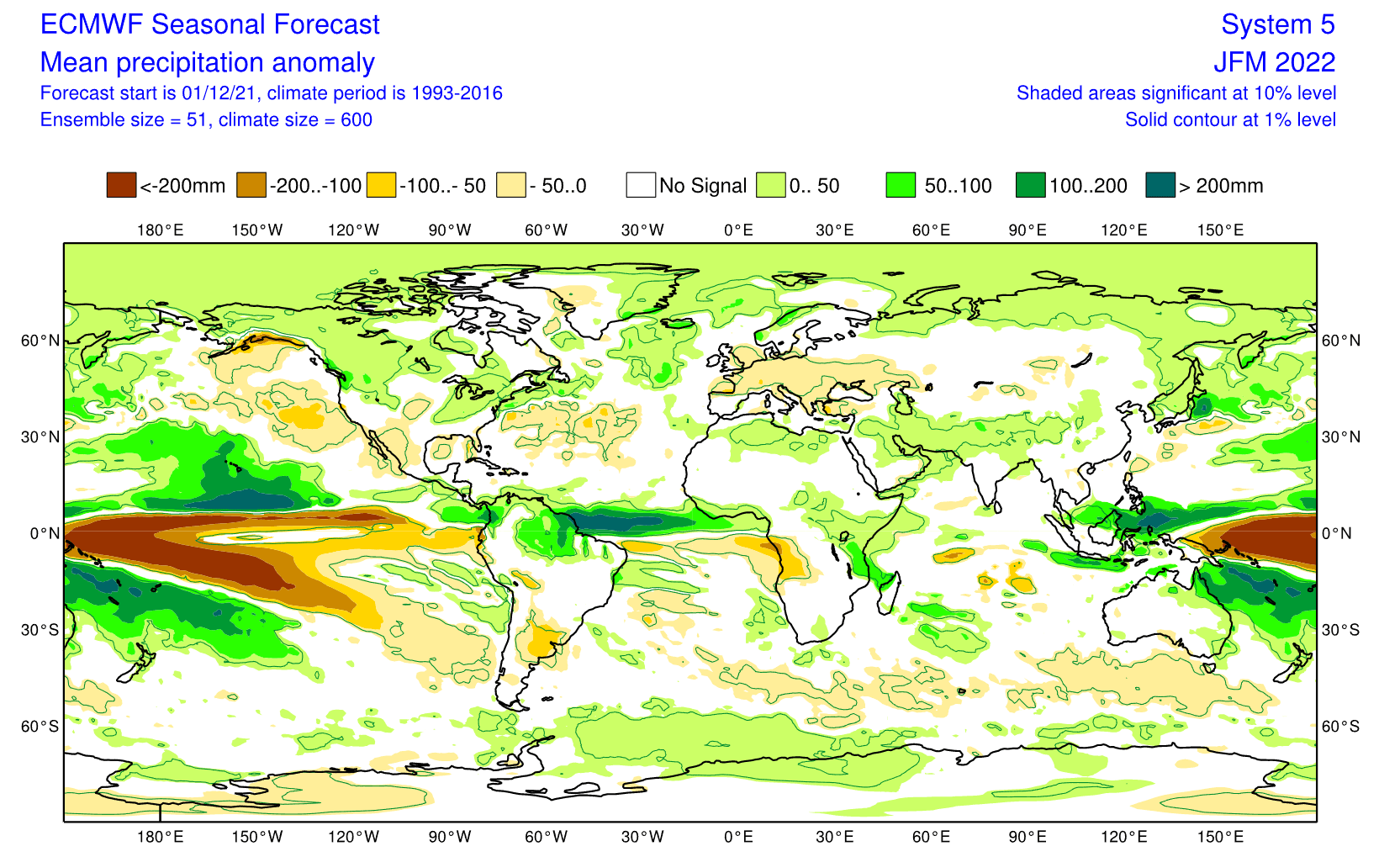
Below we have the official temperature forecast for the United States, released past NOAA, for the early 2022 flavour. It shows the temperature probability, with colder to equal chances in the northern United States. The southern half of the country and the northeast have a higher probability of warmer than normal weather, which nosotros saw in the long-range forecast above.

Such a pattern yet notwithstanding allows for stiff cold air outbreaks into the Midwest and the northeast. A strong cold pool volition be present in western Canada, which can exist a strong source of colder air. A cold air outbreak tin drop into the U.s.a. every bit soon as the pressure pattern swing allows information technology.
The official precipitation forecast also supports the models in a higher place. We see an equal-to-higher probability for more precipitation (and snowfall) in the northwestern and the northeastern United States. The Southern Us is forecast to accept a drier than normal start of 2022, thanks to the agile cold ENSO phase.
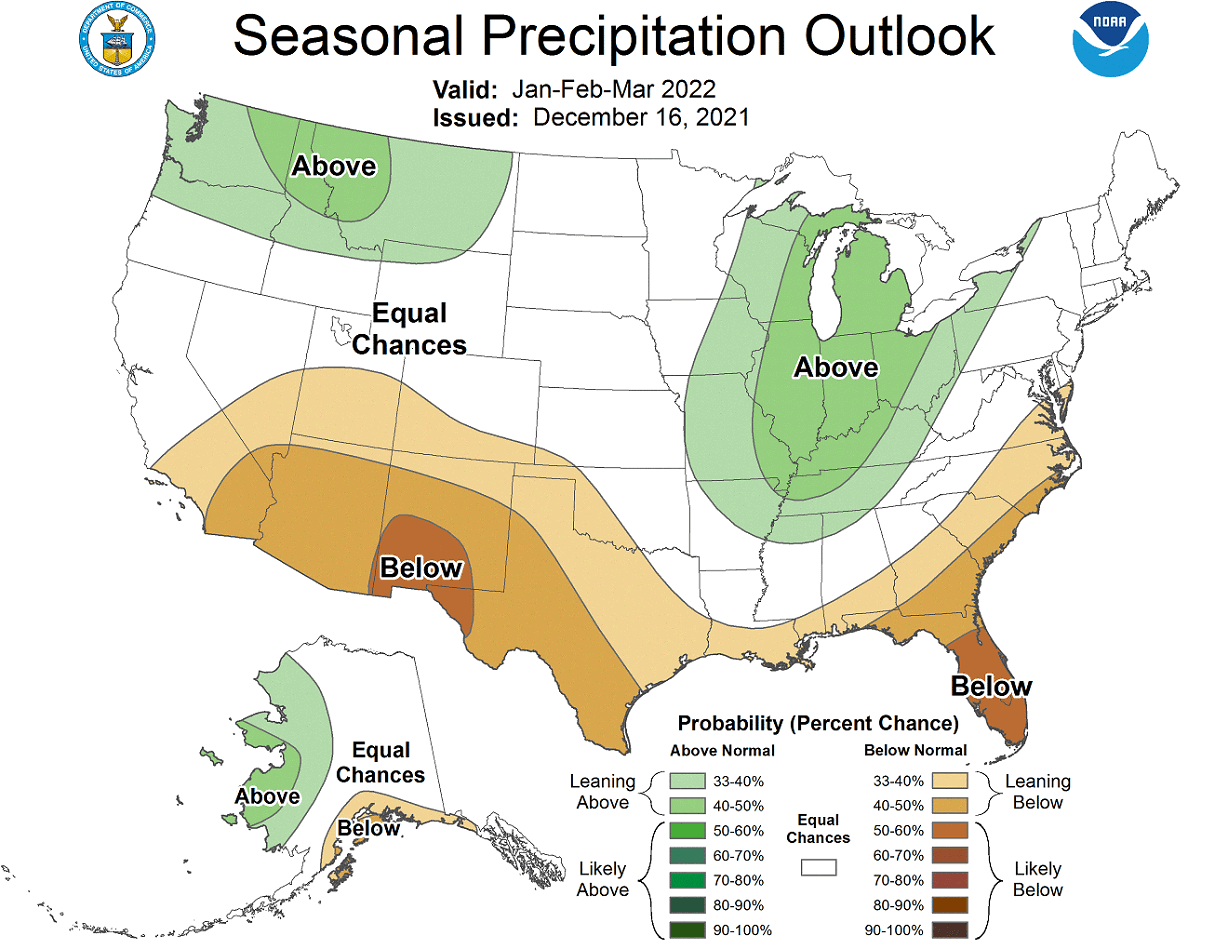
Both the actual atmospheric condition and the forecast show a articulate sign that La Nina is having a strong presence in the atmosphere. It will exert its influence on the winter season in the U.s. and the entire Northern Hemisphere, continuing besides into early Jump. The confidence is growing for a very different winter season between the northern and the southern Us.
Source: https://www.severe-weather.eu/long-range-2/la-nina-collapse-forecast-early-2022-el-nino-cold-weather-season-fa/
0 Response to "When Does Thw Weatee Start Getting Cooler Again"
Post a Comment